Neuroma: Difference between revisions
Sara Mohsin (talk | contribs) |
Sara Mohsin (talk | contribs) No edit summary |
||
| (9 intermediate revisions by the same user not shown) | |||
| Line 1: | Line 1: | ||
__NOTOC__ | __NOTOC__ | ||
{{ | {{Neuroma}} | ||
{{CMG}}; {{AE}} | {{CMG}}; {{AE}} [[User:Sara Mohsin|Sara Mohsin, M.D.]], {{MV}} | ||
{{SK}} Traumatic neuroma; Morton neuroma; Amputation neuroma; Pseudoneuroma; Morton’s metatarsalgia; Plantar interdigital neuroma; Morton's intermetatarsal neuroma; Morton's entrapment; Morton's disease; Morton's neuropathy; Morton's neuralgia; Intermetatarsal neuroma; Intermetatarsal space neuroma; Intermetatarsal nerve entrapment; Interdigital neuroma; Interdigital nerve compression; Interdigital nerve enlargement; Joplin's neuroma; Plantar neuroma; Scar neuroma; Terminal neuroma; Stump neuroma | {{SK}} Traumatic neuroma; Morton neuroma; Amputation neuroma; Pseudoneuroma; Morton’s metatarsalgia; Plantar interdigital neuroma; Morton's intermetatarsal neuroma; Morton's entrapment; Morton's disease; Morton's neuropathy; Morton's neuralgia; Intermetatarsal neuroma; Intermetatarsal space neuroma; Intermetatarsal nerve entrapment; Interdigital neuroma; Interdigital nerve compression; Interdigital nerve enlargement; Joplin's neuroma; Plantar neuroma; Scar neuroma; Terminal neuroma; Stump neuroma | ||
| Line 171: | Line 171: | ||
==Epidemiology and Demographics== | ==Epidemiology and Demographics== | ||
*Neuroma is | *Neuroma is an uncommon [[disease]]<ref name="pmid10597831">{{cite journal |vauthors=Wu J, Chiu DT |title=Painful neuromas: a review of treatment modalities |journal=Ann Plast Surg |volume=43 |issue=6 |pages=661–7 |year=1999 |pmid=10597831 |doi= |url=}}</ref> | ||
===Age=== | ===Age=== | ||
| Line 303: | Line 303: | ||
*[[Secondary prevention]] [[Measure (mathematics)|measures]] include: [[personal hygiene]] [[Measure (mathematics)|measures]], such as [[Wear red day|wearing]] [[ergonomic]] [[Shoe insert|shoes]] | *[[Secondary prevention]] [[Measure (mathematics)|measures]] include: [[personal hygiene]] [[Measure (mathematics)|measures]], such as [[Wear red day|wearing]] [[ergonomic]] [[Shoe insert|shoes]] | ||
== | ==Differential Diagnosis== | ||
*Neuroma must be [[Differentiate|differentiated]] from other [[diseases]] that [[Causes|cause]] [[Foot|forefoot]] [[pain]] and [[numbness]] such as:<ref name="morton">Neuroma. Radiopedia http://radiopaedia.org/cases/morton-neuroma-2 Accessed on April 21, 2016</ref><ref name="pmid10597831">{{cite journal |vauthors=Wu J, Chiu DT |title=Painful neuromas: a review of treatment modalities |journal=Ann Plast Surg |volume=43 |issue=6 |pages=661–7 |year=1999 |pmid=10597831 |doi= |url=}}</ref> | *Neuroma must be [[Differentiate|differentiated]] from other [[diseases]] that [[Causes|cause]] [[Foot|forefoot]] [[pain]] and [[numbness]] such as:<ref name="morton">Neuroma. Radiopedia http://radiopaedia.org/cases/morton-neuroma-2 Accessed on April 21, 2016</ref><ref name="pmid10597831">{{cite journal |vauthors=Wu J, Chiu DT |title=Painful neuromas: a review of treatment modalities |journal=Ann Plast Surg |volume=43 |issue=6 |pages=661–7 |year=1999 |pmid=10597831 |doi= |url=}}</ref> | ||
**[[Stress fracture]] ([[neck]] of the [[metatarsal]]) | **[[Stress fracture]] ([[neck]] of the [[metatarsal]]) | ||
| Line 312: | Line 312: | ||
{| class="wikitable" | {| class="wikitable" | ||
|+Differentiating neuroma from other causes of intermetatarsal pain | |+Differentiating neuroma from other causes of intermetatarsal pain | ||
!Disease/ | ! style="background: #4479BA; width: 200px;" | {{fontcolor|#FFF|Disease/Condition}} | ||
!Underlying Etiology | ! style="background: #4479BA; width: 400px;" | {{fontcolor|#FFF|Underlying Etiology}} | ||
!Pathophysiology | ! style="background: #4479BA; width: 200px;" | {{fontcolor|#FFF|Pathophysiology}} | ||
!Clinical | ! style="background: #4479BA; width: 400px;" | {{fontcolor|#FFF|Clinical presentation}} | ||
!Other associated features | ! style="background: #4479BA; width: 400px;" | {{fontcolor|#FFF|Other associated features}} | ||
|- | |- | ||
|'''Neuroma''' | | style="padding: 5px 5px; background: #DCDCDC; font-weight: bold" |'''Neuroma''' | ||
| | | | ||
Indirect [[nerve]] [[trauma]] | |||
* Especially during a [[surgery]] | |||
*[[Cone biopsy]] ([[rare]] [[Complications|complication]]) | |||
* 55% of [[hysterectomy]] [[patients]] have microneuromas, [[Association (statistics)|associated]] with [[childbirth]] | |||
*[[Traction (orthopedics)|Traction]] [[injury]] | |||
*[[Chronic (medical)|Chronic]] [[Repetitive stress injury|repetitive stress]][[Improper rotation|Improper]] [[Foot|footwear]]/tight [[Shoe insert|shoes]] | |||
*[[Repetitive stress injury|High-]][[Impacted|impact]] [[Sports medicine|sports]] (e.g., [[Rock climbing|rock-climbing]], ballet dancing, jogging, [[running]], [[snow]] skiing) | |||
*[[Repetitive stress injury|Overpronation]] | |||
| | | | ||
* [[Neural]] [[degeneration]] with [[Epineurium|epineural]] and [[Endoneurium|endoneural]] [[vascular]] [[Hyaline|hyalinization]], and [[Perineurium|perineural]] [[fibrosis]] | |||
* [[fibrosis|G]][[gross pathology|ross pathological]]<nowiki/>findings of neuroma include: | |||
**[[fibrosis|Adherent fibrofatty]] [[Tissue (biology)|tissue]] | |||
**[[fibrosis|Small, firm,]] [[oval]], yellowish-white, [[Slow|slowly]] [[Growth|growing]], [[palpable]] [[nodule]] on [[skin]] (no discoloration of [[skin]] on the [[Top7|top]] of [[nodule]]) | |||
**[[fibrosis|</=2cm in]] [[Size consistency|size]] | |||
*[[fibrosis|M]][[microscopic|icroscopic]] [[histopathological]] [[analysis]] of neuroma shows: | |||
**[[fibrosis|Extensive fibrosis around and within the]] [[nerve]] | |||
**[[fibrosis|Digital]] [[artery]] | |||
**[[fibrosis|Thrombosis]] | |||
**[[fibrosis|Arterial]] [[Thickener|thickening]] | |||
| | | | ||
*Focal [[area]] of [[Trauma|traumatic]] [[neuropathic]] [[pain]] [[Radiation|radiating]] to [[toes]]: | |||
**Shooting | |||
**[[Burn|Burning]] | |||
**Stabbing | |||
**[[Raw]] | |||
**Gnawing | |||
**[[Sick|Sickening]] [[sensations]] | |||
*[[Numbness]] | |||
*[[Paresthesias|Paresthesia]] over the [[Injured reserve list|injured]] [[area]] | |||
*[[Dysesthesia]] ([[painful]] [[hypersensitivity]] to normal [[light]] [[tactile]] [[Stimulants|stimuli]]) | |||
*[[Function (biology)|Functional]] [[impairment]] | |||
*[[Psychological]] [[distress]] (severely decreasing the [[quality of life]]) | |||
*[[Local]] [[Tenderness (medicine)|tenderness]] | |||
*[[Limiting factor|Limited]] [[range of motion]] | |||
*[[Mulder's sign]] | |||
*[[Mulder's sign|Difficulty walking]] | |||
*[[Limp|Limping]] | |||
| | | | ||
*Most common [[oral]] [[Location parameter|locations]] are: | |||
**[[Tongue]] | |||
**Near [[mental foramen]] of [[mouth]] | |||
*[[Rare|Rarely]] involves: | |||
**[[Head]] | |||
**[[Neck]] | |||
|- | |- | ||
|'''[[Metatarsal]] [[stress fracture]]''' ([[Neck]] of [[Metatarsal bones|metatarsal bone]]) | | style="padding: 5px 5px; background: #DCDCDC; font-weight: bold" |'''[[Metatarsal]] [[stress fracture]]''' ([[Neck]] of [[Metatarsal bones|metatarsal bone]])<ref name="pmid17805074">{{cite journal| author=Kelsey JL, Bachrach LK, Procter-Gray E, Nieves J, Greendale GA, Sowers M et al.| title=Risk factors for stress fracture among young female cross-country runners. | journal=Med Sci Sports Exerc | year= 2007 | volume= 39 | issue= 9 | pages= 1457-63 | pmid=17805074 | doi=10.1249/mss.0b013e318074e54b | pmc= | url=https://www.ncbi.nlm.nih.gov/entrez/eutils/elink.fcgi?dbfrom=pubmed&tool=sumsearch.org/cite&retmode=ref&cmd=prlinks&id=17805074 }} </ref> | ||
|[[Repeatability|Repeated]] extraordinary [[Stress (medicine)|stress]], overuse, or [[trauma]] to the [[bone]] [[Causes|caused]] by any of the following: | |[[Repeatability|Repeated]] extraordinary [[Stress (medicine)|stress]], overuse, or [[trauma]] to the [[bone]] [[Causes|caused]] by any of the following: | ||
* Sudden undertake of a [[Bursting|burst]] of [[exercise]] in a [[Sedentary behavior|sedentary]] [[person]] | * Sudden undertake of a [[Bursting|burst]] of [[exercise]] in a [[Sedentary behavior|sedentary]] [[person]] | ||
* Olympic-class [[Athletic training|athletics]] (extraordinary [[Quantitative|quantities]] of high-[[Impact factor|impact]] [[exercise]]) | * Olympic-class [[Athletic training|athletics]] (extraordinary [[Quantitative|quantities]] of high-[[Impact factor|impact]] [[exercise]]) | ||
* Long [[Distance matrix|distance]] marches ([[Military medicine|military]][[Recruitment status|recruits]]) | * Long [[Distance matrix|distance]] marches ([[Military medicine|military]][[Recruitment status|recruits]]) | ||
| Line 348: | Line 393: | ||
* [[Swelling]] around the [[painful]] [[area]] | * [[Swelling]] around the [[painful]] [[area]] | ||
|[[Stress fracture]] can be [[Prevention (medical)|prevented]] by following [[Measurement|measures]]: | |[[Stress fracture]] can be [[Prevention (medical)|prevented]] by following [[Measurement|measures]]: | ||
* Starting [[new]] [[exercise]] gradually with [[slow]] progression | * Starting [[new]] [[exercise]] gradually with [[slow]] progression | ||
* [[Usage analysis|Using]] proper [[Foot|footwear]] | * [[Usage analysis|Using]] proper [[Foot|footwear]] | ||
| Line 359: | Line 403: | ||
** | ** | ||
|- | |- | ||
|[[Rheumatoid arthritis|'''Rheumatoid arthritis''']] | | style="padding: 5px 5px; background: #DCDCDC; font-weight: bold" |[[Rheumatoid arthritis|'''Rheumatoid arthritis''']]<ref name="pmid19790122">{{cite journal |vauthors=Barton A, Worthington J |title=Genetic susceptibility to rheumatoid arthritis: an emerging picture |journal=Arthritis Rheum. |volume=61 |issue=10 |pages=1441–6 |date=October 2009 |pmid=19790122 |doi=10.1002/art.24672 |url=}}</ref><ref name="pmid20436074">{{cite journal |vauthors=Hitchon CA, Chandad F, Ferucci ED, Willemze A, Ioan-Facsinay A, van der Woude D, Markland J, Robinson D, Elias B, Newkirk M, Toes RM, Huizinga TW, El-Gabalawy HS |title=Antibodies to porphyromonas gingivalis are associated with anticitrullinated protein antibodies in patients with rheumatoid arthritis and their relatives |journal=J. Rheumatol. |volume=37 |issue=6 |pages=1105–12 |date=June 2010 |pmid=20436074 |doi=10.3899/jrheum.091323 |url=}}</ref><ref name="pmid21343168">{{cite journal |vauthors=Routsias JG, Goules JD, Goules A, Charalampakis G, Pikazis D |title=Autopathogenic correlation of periodontitis and rheumatoid arthritis |journal=Rheumatology (Oxford) |volume=50 |issue=7 |pages=1189–93 |date=July 2011 |pmid=21343168 |doi=10.1093/rheumatology/ker090 |url=}}</ref><ref name="pmid10366115">{{cite journal |vauthors=Barrett JH, Brennan P, Fiddler M, Silman AJ |title=Does rheumatoid arthritis remit during pregnancy and relapse postpartum? Results from a nationwide study in the United Kingdom performed prospectively from late pregnancy |journal=Arthritis Rheum. |volume=42 |issue=6 |pages=1219–27 |date=June 1999 |pmid=10366115 |doi=10.1002/1529-0131(199906)42:6<1219::AID-ANR19>3.0.CO;2-G |url=}}</ref><ref name="pmid26435495">{{cite journal |vauthors=Louati K, Berenbaum F |title=Fatigue in chronic inflammation - a link to pain pathways |journal=Arthritis Res. Ther. |volume=17 |issue= |pages=254 |date=October 2015 |pmid=26435495 |pmc=4593220 |doi=10.1186/s13075-015-0784-1 |url=}}</ref><ref name="pmid23335492">{{cite journal |vauthors=Nikolaus S, Bode C, Taal E, van de Laar MA |title=Fatigue and factors related to fatigue in rheumatoid arthritis: a systematic review |journal=Arthritis Care Res (Hoboken) |volume=65 |issue=7 |pages=1128–46 |date=July 2013 |pmid=23335492 |doi=10.1002/acr.21949 |url=}}</ref> | ||
|Common [[causes]] include: | |Common [[causes]] include: | ||
* [[Idiopathic]] | * [[Idiopathic]] | ||
* [[Genetic]] ([[HLA-DR4]] [[Cluster (epidemiology)|cluster]], [[HLA-DR1]]) | * [[Genetic]] ([[HLA-DR4]] [[Cluster (epidemiology)|cluster]], [[HLA-DR1]]) | ||
| Line 372: | Line 415: | ||
* [[Lifestyle]] factors ([[obesity]], poor [[health]]) | * [[Lifestyle]] factors ([[obesity]], poor [[health]]) | ||
|On [[gross pathology]], following [[Features (pattern recognition)|features]] may be noticed: | |On [[gross pathology]], following [[Features (pattern recognition)|features]] may be noticed: | ||
* [[Irregular lesion|Irregular]] [[Surface anatomy|surface]], seen due to [[synovial]] [[hyperplasia]] | * [[Irregular lesion|Irregular]] [[Surface anatomy|surface]], seen due to [[synovial]] [[hyperplasia]] | ||
* Subchondral [[cysts]](usually [[Presenting symptom|present]] at the later stage of [[disease]]) | * Subchondral [[cysts]](usually [[Presenting symptom|present]] at the later stage of [[disease]]) | ||
[[Microscopic]] [[histopathological]][[analysis]] shows: | [[Microscopic]] [[histopathological]][[analysis]] shows: | ||
* [[Formation matrix|Formation]] of [[new]] [[synovial]][[Blood vessel|blood vessels]] (earliest finding) | * [[Formation matrix|Formation]] of [[new]] [[synovial]][[Blood vessel|blood vessels]] (earliest finding) | ||
* [[Hypertrophy (medical)|Hypertrophy]] of [[synovial]] [[Line|lining]]<nowiki/>layer | * [[Hypertrophy (medical)|Hypertrophy]] of [[synovial]] [[Line|lining]]<nowiki/>layer | ||
| Line 384: | Line 424: | ||
* [[Pannus]] [[Formation matrix|formation]](fibrovascular [[Tissue (biology)|tissue]] or [[granulation tissue]]) | * [[Pannus]] [[Formation matrix|formation]](fibrovascular [[Tissue (biology)|tissue]] or [[granulation tissue]]) | ||
|Common [[symptoms]] of [[rheumatoid arthritis]] include: | |Common [[symptoms]] of [[rheumatoid arthritis]] include: | ||
* [[Joint pain]] involving small [[Joints (anatomy)|joints]] of the [[hands]], [[wrist]], and [[foot]] | * [[Joint pain]] involving small [[Joints (anatomy)|joints]] of the [[hands]], [[wrist]], and [[foot]] | ||
* [[Joint swelling]] | * [[Joint swelling]] | ||
| Line 398: | Line 437: | ||
** [[Weakness]] in the [[arm]] | ** [[Weakness]] in the [[arm]] | ||
|[[Condition|Conditions]] [[Association (statistics)|associated]] with [[rheumatoid arthritis]] include: | |[[Condition|Conditions]] [[Association (statistics)|associated]] with [[rheumatoid arthritis]] include: | ||
* [[Osteopenia]] | * [[Osteopenia]] | ||
* [[Myositis]] | * [[Myositis]] | ||
| Line 416: | Line 454: | ||
* [[Sjogren's syndrome]] | * [[Sjogren's syndrome]] | ||
* [[Felty's syndrome]] | * [[Felty's syndrome]] | ||
[[Patients]] with [[rheumatoid arthritis]] may have a positive [[History and Physical examination|history]] of: | [[Patients]] with [[rheumatoid arthritis]] may have a positive [[History and Physical examination|history]] of: | ||
* [[Smoking]] | * [[Smoking]] | ||
* [[Family history]] | * [[Family history]] | ||
* [[Autoimmune disease]] | * [[Autoimmune disease]] | ||
|- | |- | ||
|[[Hammer toe|'''Hammer toe''']] | | style="padding: 5px 5px; background: #DCDCDC; font-weight: bold" |[[Hammer toe|'''Hammer toe''']]<ref name="pmid30309185">{{cite journal| author=Ridley LJ, Han J, Ridley WE, Xiang H| title=Claw toe. | journal=J Med Imaging Radiat Oncol | year= 2018 | volume= 62 Suppl 1 | issue= | pages= 126 | pmid=30309185 | doi=10.1111/1754-9485.07_12786 | pmc= | url=https://www.ncbi.nlm.nih.gov/entrez/eutils/elink.fcgi?dbfrom=pubmed&tool=sumsearch.org/cite&retmode=ref&cmd=prlinks&id=30309185 }} </ref><ref name="pmid30553747">{{cite journal| author=Ceccarini P, Rinonapoli G, Sebastiani E, Bisaccia M, Ceccarini A, Caraffa A| title=Clinical Comparison Between Shortening Osteotomy of the Proximal Phalanx Neck and Arthrodesis in Hammer Toe Surgery at Mid-TermFollow-Up. | journal=J Foot Ankle Surg | year= 2019 | volume= 58 | issue= 2 | pages= 221-225 | pmid=30553747 | doi=10.1053/j.jfas.2018.08.002 | pmc= | url=https://www.ncbi.nlm.nih.gov/entrez/eutils/elink.fcgi?dbfrom=pubmed&tool=sumsearch.org/cite&retmode=ref&cmd=prlinks&id=30553747 }} </ref><ref name="pmid29362037">{{cite journal| author=Doty JF, Fogleman JA| title=Treatment of Rigid Hammer-Toe Deformity: Permanent Versus Removable Implant Selection. | journal=Foot Ankle Clin | year= 2018 | volume= 23 | issue= 1 | pages= 91-101 | pmid=29362037 | doi=10.1016/j.fcl.2017.09.007 | pmc= | url=https://www.ncbi.nlm.nih.gov/entrez/eutils/elink.fcgi?dbfrom=pubmed&tool=sumsearch.org/cite&retmode=ref&cmd=prlinks&id=29362037 }} </ref><ref name="pmid29444584">{{cite journal| author=Mueller CM, Boden SA, Boden AL, Maidman SD, Cutler A, Mignemi D et al.| title=Complication Rates and Short-Term Outcomes After Operative Hammertoe Correction in Older Patients. | journal=Foot Ankle Int | year= 2018 | volume= 39 | issue= 6 | pages= 681-688 | pmid=29444584 | doi=10.1177/1071100718755472 | pmc= | url=https://www.ncbi.nlm.nih.gov/entrez/eutils/elink.fcgi?dbfrom=pubmed&tool=sumsearch.org/cite&retmode=ref&cmd=prlinks&id=29444584 }} </ref><ref name="pmid25746765">{{cite journal| author=Ceccarini P, Ceccarini A, Rinonapoli G, Caraffa A| title=Correction of Hammer Toe Deformity of Lateral Toes With Subtraction Osteotomy of the Proximal Phalanx Neck. | journal=J Foot Ankle Surg | year= 2015 | volume= 54 | issue= 4 | pages= 601-6 | pmid=25746765 | doi=10.1053/j.jfas.2014.11.013 | pmc= | url=https://www.ncbi.nlm.nih.gov/entrez/eutils/elink.fcgi?dbfrom=pubmed&tool=sumsearch.org/cite&retmode=ref&cmd=prlinks&id=25746765 }} </ref><ref name="pmid26028601">{{cite journal| author=Basile A, Albo F, Via AG| title=Intramedullary Fixation System for the Treatment of Hammertoe Deformity. | journal=J Foot Ankle Surg | year= 2015 | volume= 54 | issue= 5 | pages= 910-6 | pmid=26028601 | doi=10.1053/j.jfas.2015.04.004 | pmc= | url=https://www.ncbi.nlm.nih.gov/entrez/eutils/elink.fcgi?dbfrom=pubmed&tool=sumsearch.org/cite&retmode=ref&cmd=prlinks&id=26028601 }} </ref><ref name="pmid24443491">{{cite journal| author=Catena F, Doty JF, Jastifer J, Coughlin MJ, Stevens F| title=Prospective study of hammertoe correction with an intramedullary implant. | journal=Foot Ankle Int | year= 2014 | volume= 35 | issue= 4 | pages= 319-25 | pmid=24443491 | doi=10.1177/1071100713519780 | pmc= | url=https://www.ncbi.nlm.nih.gov/entrez/eutils/elink.fcgi?dbfrom=pubmed&tool=sumsearch.org/cite&retmode=ref&cmd=prlinks&id=24443491 }} </ref><ref name="pmid29337598">{{cite journal| author=Obrador C, Losa-Iglesias M, Becerro-de-Bengoa-Vallejo R, Kabbash CA| title=Comparative Study of Intramedullary Hammertoe Fixation. | journal=Foot Ankle Int | year= 2018 | volume= 39 | issue= 4 | pages= 415-425 | pmid=29337598 | doi=10.1177/1071100717745854 | pmc= | url=https://www.ncbi.nlm.nih.gov/entrez/eutils/elink.fcgi?dbfrom=pubmed&tool=sumsearch.org/cite&retmode=ref&cmd=prlinks&id=29337598 }} </ref><ref name="pmid25677363">{{cite journal| author=Kramer WC, Parman M, Marks RM| title=Hammertoe correction with k-wire fixation. | journal=Foot Ankle Int | year= 2015 | volume= 36 | issue= 5 | pages= 494-502 | pmid=25677363 | doi=10.1177/1071100714568013 | pmc= | url=https://www.ncbi.nlm.nih.gov/entrez/eutils/elink.fcgi?dbfrom=pubmed&tool=sumsearch.org/cite&retmode=ref&cmd=prlinks&id=25677363 }} </ref> | ||
| | |Can be [[Causes|caused]] by [[muscle]], [[nerve]], or [[Joint (anatomy)|joint]] damage due to any of the following: | ||
| | |||
* [[Wear red day|Wearing]] poorly-fitting [[Shoe insert|shoes]] (high [[Heel|heels]], too short or narrow [[Shoe insert|shoes]]) | |||
* [[Trauma]] | |||
* [[Osteoarthritis]] | |||
* [[Rheumatoid arthritis]] | |||
* [[Stroke]] | |||
* [[Charcot-Marie-Tooth disease]] | |||
* [[Diabetes]] | |||
| | | | ||
* [[Abnormal]] permanent [[Bends|bend]] at the [[proximal interphalangeal joint]] of a [[toe]] due to [[imbalance]] in the [[muscles]], [[ligaments]], or [[tendons]] which normally [[Holdfast|hold]] the [[toe]] in a [[Straight, Incorporated|straight]] [[Position effect|position]] | |||
| | | | ||
* Usually [[Affect|affects]] [[second]], third, or fourth [[toe]] | |||
* [[Abnormal]] [[Bends|bend]] in the [[Joint (anatomy)|joint]] of one or more [[toes]] resembling a [[Hammer toe|hammer]] | |||
* [[Painful]] or difficult [[Movement disorders|movement]] of the [[Affect|affected]] [[toe]] | |||
*[[Painful]] [[Callus (cell biology)|calluses]] & [[corns]] may [[Formal charge|form]] (due to rubbing of [[Hammer toe|hammer toes]] against the inside of the [[Shoe insert|shoes]]) | |||
|Also known as: | |||
* [[Claw]] [[toe]] | |||
* [[Hammer toe]] [[syndrome]] | |||
* Mallet [[toe]] (when [[Affect|affects]] the [[Distal interphalangeal joint|distal interphalangeal joint)]] | |||
|- | |- | ||
|'''[[Neurofibroma]]''' | | style="padding: 5px 5px; background: #DCDCDC; font-weight: bold" |'''[[Neurofibroma]]'''<ref name="RodriguezFolpe2012">{{cite journal|last1=Rodriguez|first1=Fausto J.|last2=Folpe|first2=Andrew L.|last3=Giannini|first3=Caterina|last4=Perry|first4=Arie|title=Pathology of peripheral nerve sheath tumors: diagnostic overview and update on selected diagnostic problems|journal=Acta Neuropathologica|volume=123|issue=3|year=2012|pages=295–319|issn=0001-6322|doi=10.1007/s00401-012-0954-z}}</ref><ref name="ChoiKomurov2017">{{cite journal|last1=Choi|first1=Kwangmin|last2=Komurov|first2=Kakajan|last3=Fletcher|first3=Jonathan S.|last4=Jousma|first4=Edwin|last5=Cancelas|first5=Jose A.|last6=Wu|first6=Jianqiang|last7=Ratner|first7=Nancy|title=An inflammatory gene signature distinguishes neurofibroma Schwann cells and macrophages from cells in the normal peripheral nervous system|journal=Scientific Reports|volume=7|issue=1|year=2017|issn=2045-2322|doi=10.1038/srep43315}}</ref><ref name="LiaoBooker2018">{{cite journal|last1=Liao|first1=Chung-Ping|last2=Booker|first2=Reid C.|last3=Brosseau|first3=Jean-Philippe|last4=Chen|first4=Zhiguo|last5=Mo|first5=Juan|last6=Tchegnon|first6=Edem|last7=Wang|first7=Yong|last8=Clapp|first8=D. Wade|last9=Le|first9=Lu Q.|title=Contributions of inflammation and tumor microenvironment to neurofibroma tumorigenesis|journal=Journal of Clinical Investigation|volume=128|issue=7|year=2018|pages=2848–2861|issn=0021-9738|doi=10.1172/JCI99424}}</ref><ref name="StaserYang2010">{{cite journal|last1=Staser|first1=K.|last2=Yang|first2=F.-C.|last3=Clapp|first3=D. W.|title=Mast cells and the neurofibroma microenvironment|journal=Blood|volume=116|issue=2|year=2010|pages=157–164|issn=0006-4971|doi=10.1182/blood-2009-09-242875}}</ref><ref name="MuirNeubauer2001">{{cite journal|last1=Muir|first1=David|last2=Neubauer|first2=Debbie|last3=Lim|first3=Ingrid T.|last4=Yachnis|first4=Anthony T.|last5=Wallace|first5=Margaret R.|title=Tumorigenic Properties of Neurofibromin-Deficient Neurofibroma Schwann Cells|journal=The American Journal of Pathology|volume=158|issue=2|year=2001|pages=501–513|issn=00029440|doi=10.1016/S0002-9440(10)63992-2}}</ref><ref name="WilkinsonManson2004">{{cite journal|last1=Wilkinson|first1=Lana M.|last2=Manson|first2=David|last3=Smith|first3=Charles R.|title=Best Cases from the AFIP|journal=RadioGraphics|volume=24|issue=suppl_1|year=2004|pages=S237–S242|issn=0271-5333|doi=10.1148/rg.24si035170}}</ref><ref name="BernthalJones2013">{{cite journal|last1=Bernthal|first1=Nicholas|last2=Jones|first2=Kevin|last3=Monument|first3=Michael|last4=Liu|first4=Ting|last5=Viskochil|first5=David|last6=Randall|first6=R.|title=Lost in Translation: Ambiguity in Nerve Sheath Tumor Nomenclature and Its Resultant Treatment Effect|journal=Cancers|volume=5|issue=4|year=2013|pages=519–528|issn=2072-6694|doi=10.3390/cancers5020519}}</ref><ref name="StaserYang2010">{{cite journal|last1=Staser|first1=K.|last2=Yang|first2=F.-C.|last3=Clapp|first3=D. W.|title=Mast cells and the neurofibroma microenvironment|journal=Blood|volume=116|issue=2|year=2010|pages=157–164|issn=0006-4971|doi=10.1182/blood-2009-09-242875}}</ref><ref name="MautnerFriedrich2003">{{cite journal|last1=Mautner|first1=V. F.|last2=Friedrich|first2=R. E.|last3=von Deimling|first3=A.|last4=Hagel|first4=C.|last5=Korf|first5=B.|last6=Knöfel|first6=M. T.|last7=Wenzel|first7=R.|last8=Fünsterer|first8=C.|title=Malignant peripheral nerve sheath tumours in neurofibromatosis type 1: MRI supports the diagnosis of malignant plexiform neurofibroma|journal=Neuroradiology|volume=45|issue=9|year=2003|pages=618–625|issn=0028-3940|doi=10.1007/s00234-003-0964-6}}</ref><ref name="ShenHarper1996">{{cite journal|last1=Shen|first1=M H|last2=Harper|first2=P S|last3=Upadhyaya|first3=M|title=Molecular genetics of neurofibromatosis type 1 (NF1).|journal=Journal of Medical Genetics|volume=33|issue=1|year=1996|pages=2–17|issn=1468-6244|doi=10.1136/jmg.33.1.2}}</ref><ref name="RubinGutmann2005">{{cite journal|last1=Rubin|first1=Joshua B.|last2=Gutmann|first2=David H.|title=Neurofibromatosis type 1 — a model for nervous system tumour formation?|journal=Nature Reviews Cancer|volume=5|issue=7|year=2005|pages=557–564|issn=1474-175X|doi=10.1038/nrc1653}}</ref><ref name="Gray1990">{{cite journal|last1=Gray|first1=Mark H.|title=Immunohistochemical Demonstration of Factor XIIIa Expression in Neurofibromas|journal=Archives of Dermatology|volume=126|issue=4|year=1990|pages=472|issn=0003-987X|doi=10.1001/archderm.1990.01670280056009}}</ref> | ||
|Can be sporadic or as a part of [[Neurofibromatosis 1]] and 2 | |Can be sporadic or as a part of [[Neurofibromatosis 1]] and 2 | ||
* ''[[Neurofibromatosis type I|NF1]] [[gene]] located at [[chromosomal]] region [[CCL7|17q11.2]], [[Code|codes]]<nowiki/>for''[[neurofibromin]] | * ''[[Neurofibromatosis type I|NF1]] [[gene]] located at [[chromosomal]] region [[CCL7|17q11.2]], [[Code|codes]]<nowiki/>for''[[neurofibromin]] | ||
* Functional part of [[neurofibromin]] GAP (or [[GTPase-activating proteins|GTPase-activating protein]]) accelerates the [[Conversion (logic)|conversion]]<nowiki/>of the active [[GTP-binding protein|GTP]]-bound [[RAS]] to its inactive GDP-[[Bound state|bound]] form | * Functional part of [[neurofibromin]] GAP (or [[GTPase-activating proteins|GTPase-activating protein]]) accelerates the [[Conversion (logic)|conversion]]<nowiki/>of the active [[GTP-binding protein|GTP]]-bound [[RAS]] to its inactive GDP-[[Bound state|bound]] form | ||
| Line 438: | Line 490: | ||
* Uniphasic, low to moderate cellularity | * Uniphasic, low to moderate cellularity | ||
* No peripheral perineural [[capsule]] | * No peripheral perineural [[capsule]] | ||
* [[Random]] [[pattern]], only [[rare]]<nowiki/>palisading | * [[Random]] [[pattern]], only [[rare]]<nowiki/> palisading | ||
* No well formed verocy bodies | * No well formed verocy bodies | ||
* Hypocellular with abundant [[mucinous]]/myxoid [[matrix]]<nowiki/>without hypercellular [[Area|areas]] | * Hypocellular with abundant [[mucinous]]/myxoid [[matrix]]<nowiki/>without hypercellular [[Area|areas]] | ||
| Line 451: | Line 503: | ||
* Pseudomeissnerian [[Body|bodies]]<nowiki/>representing specific [[differentiation]] may be present | * Pseudomeissnerian [[Body|bodies]]<nowiki/>representing specific [[differentiation]] may be present | ||
* Lacks storiform [[pattern]] | * Lacks storiform [[pattern]] | ||
[[Neurofibroma]] with [[degenerative]][[atypia]] ("ancient [[Change detection|change]]") has following [[microscopic]] [[Features (pattern recognition)|features]]: | [[Neurofibroma]] with [[degenerative]][[atypia]] ("ancient [[Change detection|change]]") has following [[microscopic]] [[Features (pattern recognition)|features]]: | ||
* [[Localized disease|Localized]] [[Cells (biology)|cells]] with large [[pleomorphic]] [[nuclei]], [[cytoplasmic]] [[nuclear]][[inclusions]], smudgy [[chromatin]], and inconspicuous [[nuclei]] | * [[Localized disease|Localized]] [[Cells (biology)|cells]] with large [[pleomorphic]] [[nuclei]], [[cytoplasmic]] [[nuclear]][[inclusions]], smudgy [[chromatin]], and inconspicuous [[nuclei]] | ||
* Absent or very low [[Mitotic|mitotic activity]] | * Absent or very low [[Mitotic|mitotic activity]] | ||
| Line 459: | Line 509: | ||
| | | | ||
* Can occur anywhere | * Can occur anywhere | ||
* [[Diffuse]][[ | * [[Diffuse]] [[neurofibroma]]<nowiki/>[[Neurofibroma|s]] commonly involve [[scalp]] | ||
* Soft [[Mass|masses]]/[[Bumps on skin|bumps on or under skin]] ([[internal]] or [[superficial]]) | * Soft [[Mass|masses]]/[[Bumps on skin|bumps on or under skin]] ([[internal]] or [[superficial]]) | ||
* [[Transient]] [[itching]] ([[mast cells]]<nowiki/>release [[histamine]]) | * [[Transient]] [[itching]] ([[mast cells]]<nowiki/>release [[histamine]]) | ||
Revision as of 17:31, 8 July 2020
|
Neuroma Microchapters |
Editor-In-Chief: C. Michael Gibson, M.S., M.D. [7]; Associate Editor(s)-in-Chief: Sara Mohsin, M.D., Maria Fernanda Villarreal, M.D. [8]
Synonyms and keywords: Traumatic neuroma; Morton neuroma; Amputation neuroma; Pseudoneuroma; Morton’s metatarsalgia; Plantar interdigital neuroma; Morton's intermetatarsal neuroma; Morton's entrapment; Morton's disease; Morton's neuropathy; Morton's neuralgia; Intermetatarsal neuroma; Intermetatarsal space neuroma; Intermetatarsal nerve entrapment; Interdigital neuroma; Interdigital nerve compression; Interdigital nerve enlargement; Joplin's neuroma; Plantar neuroma; Scar neuroma; Terminal neuroma; Stump neuroma
Overview
Neuroma (Neuro- is from the Greek for nerve) is defined as a benign tumor of a nerve. However, neuroma commonly refers to any tumor of cells of the nervous system. Neuromas form part of the peripheral nerve sheath tumors and belong to Reactive class of tumors. Neuroma was first described by Thomas Morton in 1876. Neuromas may be classified according to histopathological features into 3 groups: Morton's neuroma, traumatic neuroma, and neoplasic neuromas. The pathogenesis of neuroma is characterized by neural degeneration with epineural and endoneural vascular hyalinization, and perineural fibrosis. Neuroma is more commonly observed among patients aged between 15 to 50 years old. Neuroma is more commonly observed among middle aged adults. Females are more commonly affected with neuroma than males. The female to male ratio is approximately 5:1. Common risk factors in the development of neuroma include improper footwear and high impact sports (e.g., rock-climbing, ballet dancing). A major complication of neuroma is chronic neuropathic pain. On ultrasound, neuroma is characterized as a well-defined, hypoechoic lesion located in the intermetatarsal space proximal to the metatarsal head. Patients with neuroma usually appear with antalgic posture. Physical examination may be remarkable for tenderness to palpation and dysesthetic pain. Surgical excision is the treatment of choice for patients with neuroma; this surgical intervention is associated with a relatively favorable success rate, approximately 80%. The recurrence rate after surgery is as high as 50%.
Historical Perspective
- The term neuroma originates from the following two Greek words:
- In 1876, Neuroma was first described by Thomas Morton
Classification
- Neuroma may be classified according to histopathological features into following groups:[1][2][3][4]
Pathophysiology
- The pathogenesis of neuroma is characterized by neural degeneration with epineural and endoneural vascular hyalinization, and perineural fibrosis[1]
- The pathogenesis of traumatic neuroma is characterized by:[34][18][35]
- Tangle of neural fibers and connective tissue that develops following a peripheral nerve injury
- Interruption in continuity of nerve causing wallerian degeneration (loss of axons in proximal stump and retraction of axons in distal segment), followed by exuberant regeneration of nerve and formation of mass of Schwann cells, axons and fibrous cells
- Chronic reactive fibroinflammatory disorganized regeneration around a nerve after an injury (such as traction injury or chronic repetitive stress)
- Morton's neuroma is characterized by being located in the 3rd web-space, between 3rd and 4th metatarsal heads, or sometimes in the second or fourth interspaces
- Another subtype of traumatic neuroma is terminal neuroma (also known as "stump neuroma") which can occur after transection of the nerve (e.g. limb amputation)
- There are no genetic mutations associated with the development of neuroma
- On gross pathology, characteristic findings of neuroma, includes:[36] [37][38]
- On microscopic histopathological analysis, characteristic findings of neuroma, include:[37][38]
- Extensive fibrosis around and within the nerve
- Digital artery
- Thrombosis
- Arterial thickening
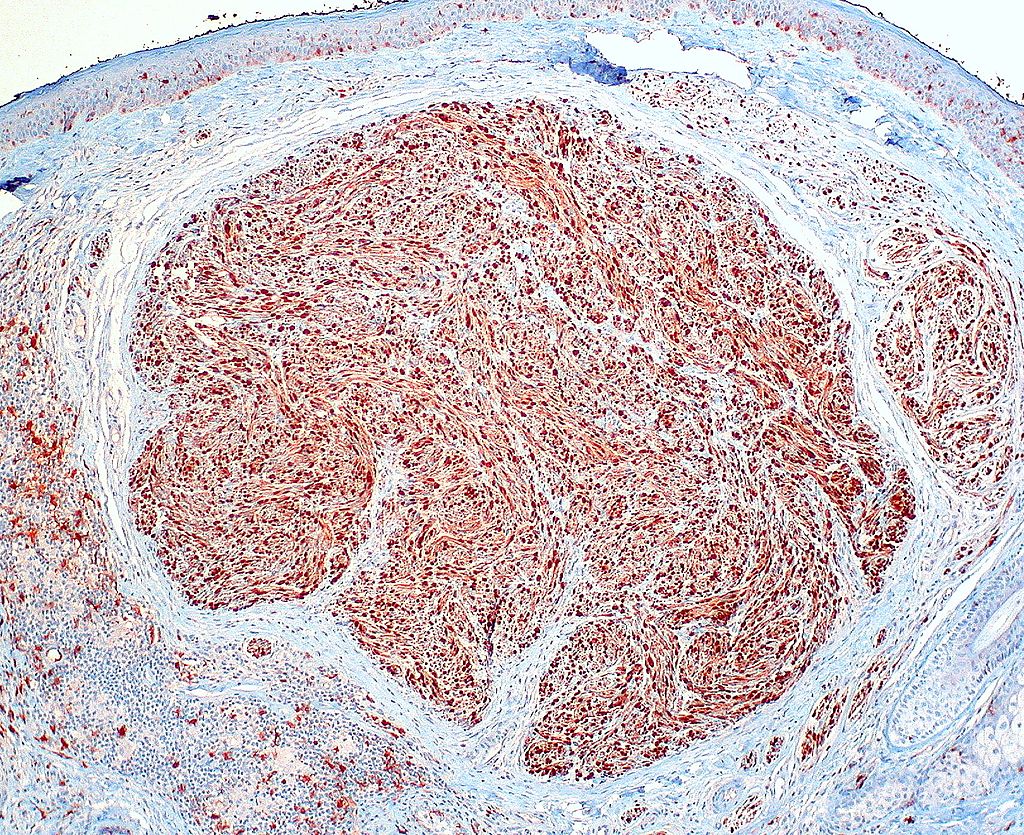 |
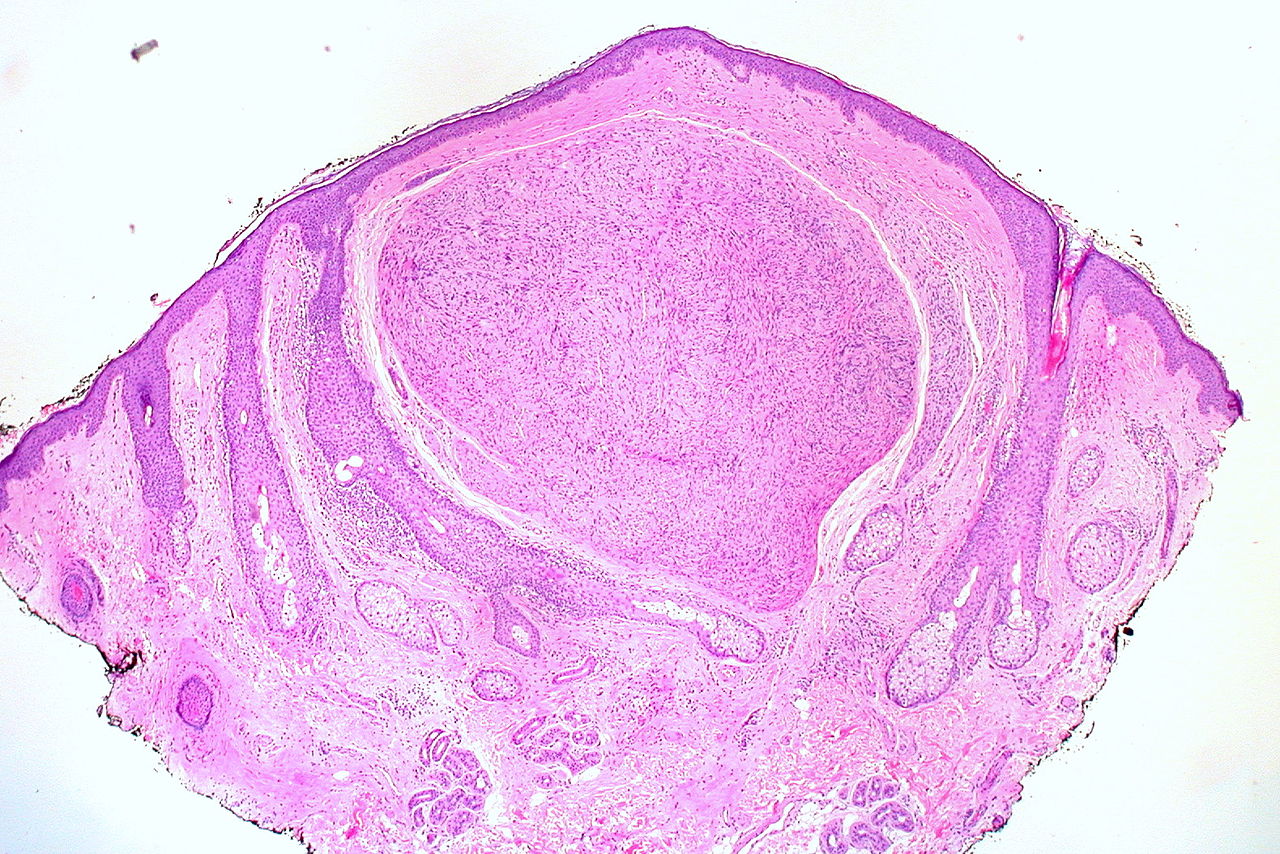 |
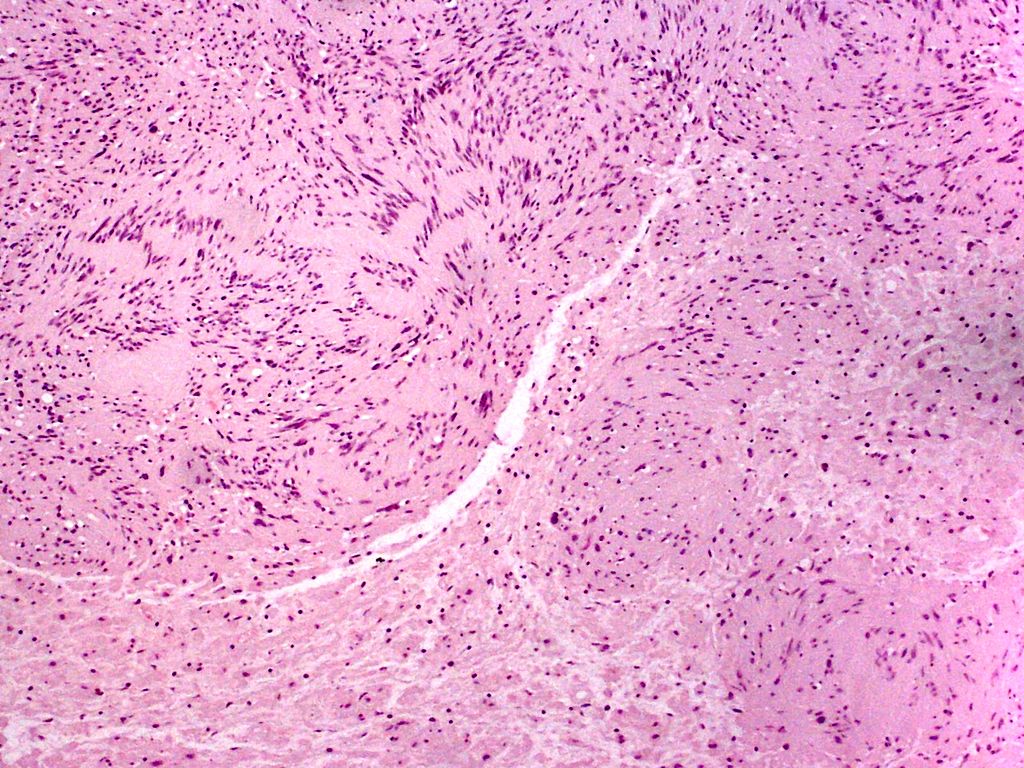 |
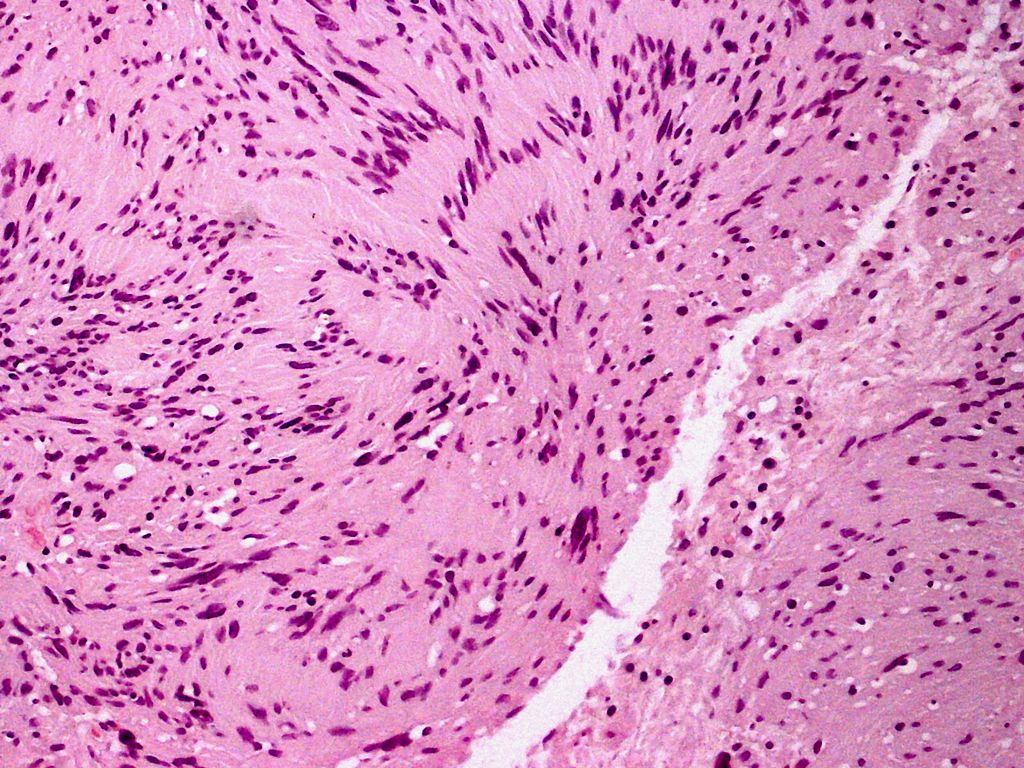 |
Histopathology of traumatic neuroma
- Numerous well formed small nerve twigs
- Limited soft tissue infiltration
- Contains axons in haphazardly arranged nerves within mature collagenous scar with entrapped smooth muscle
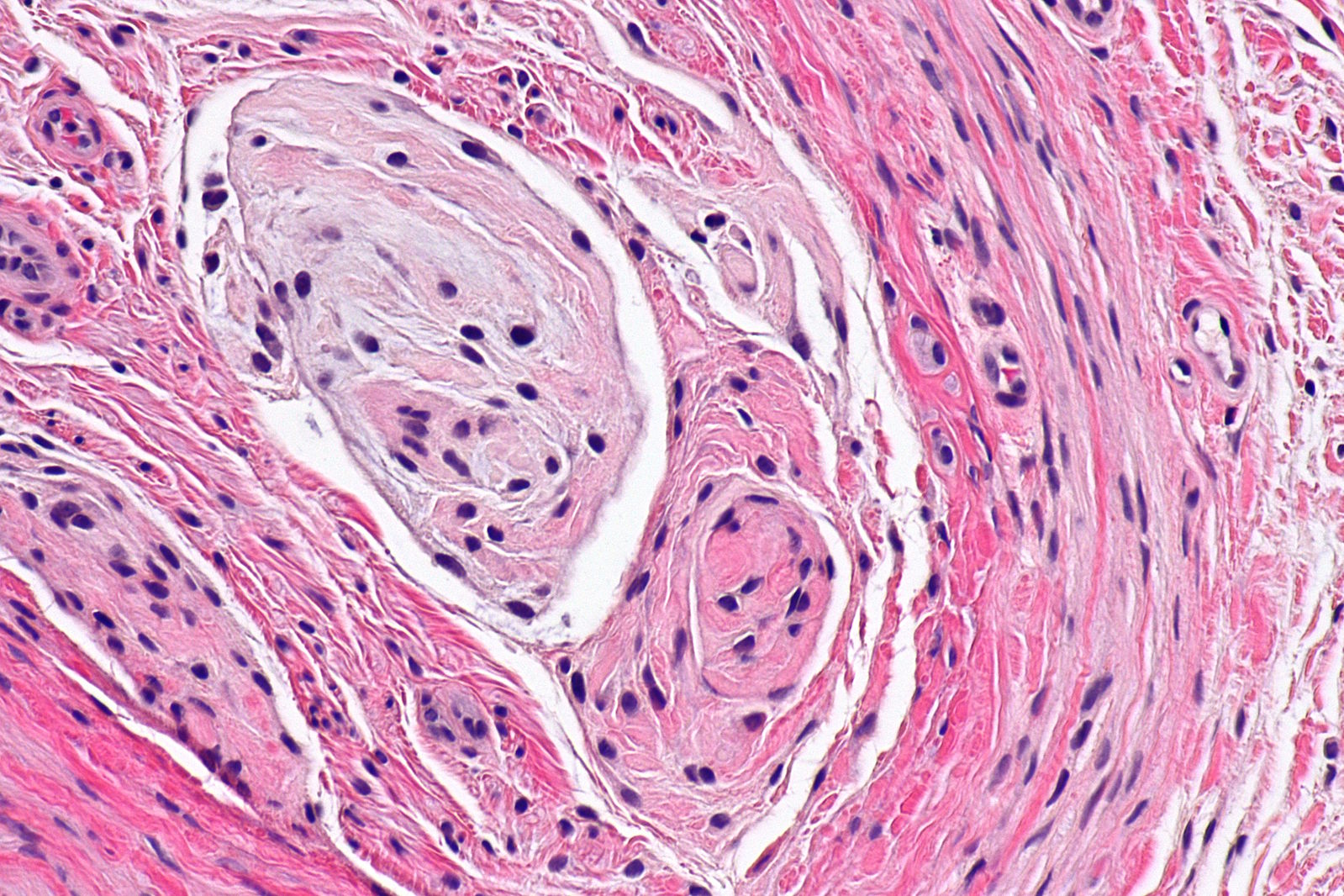 |
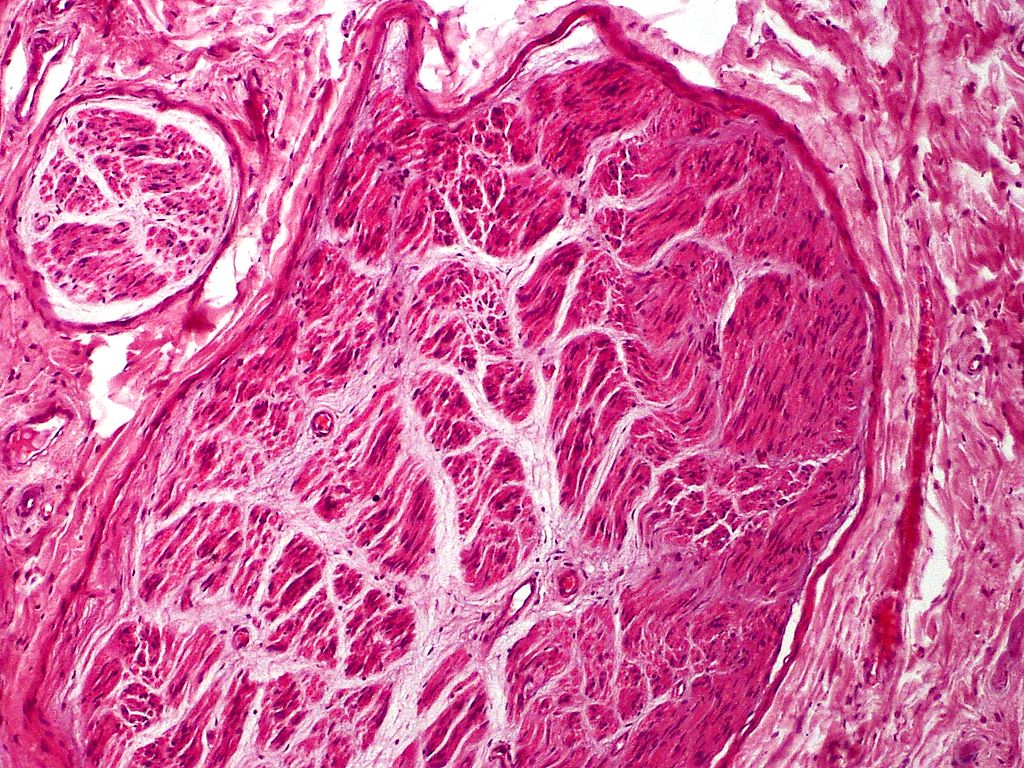 |
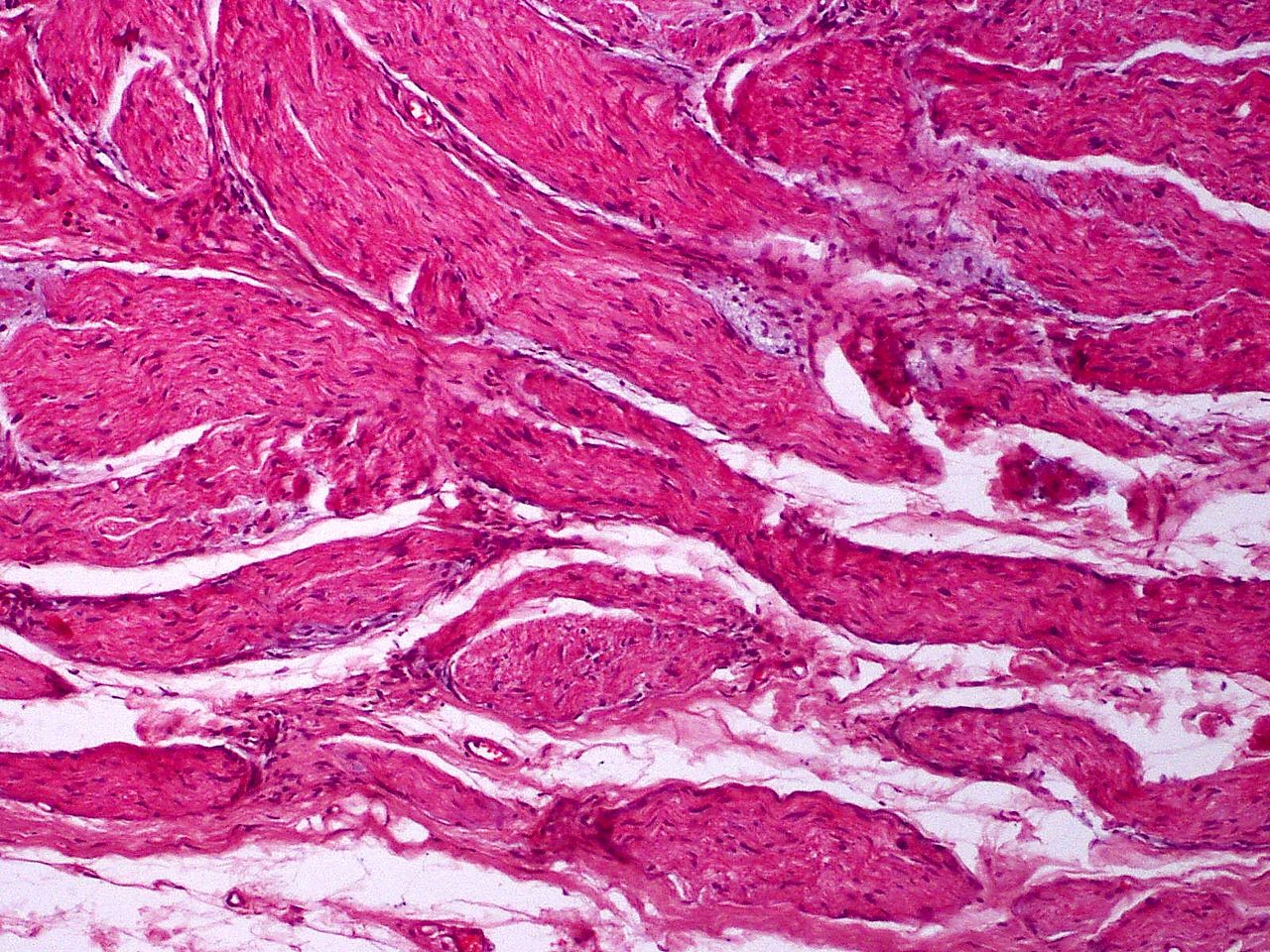 |
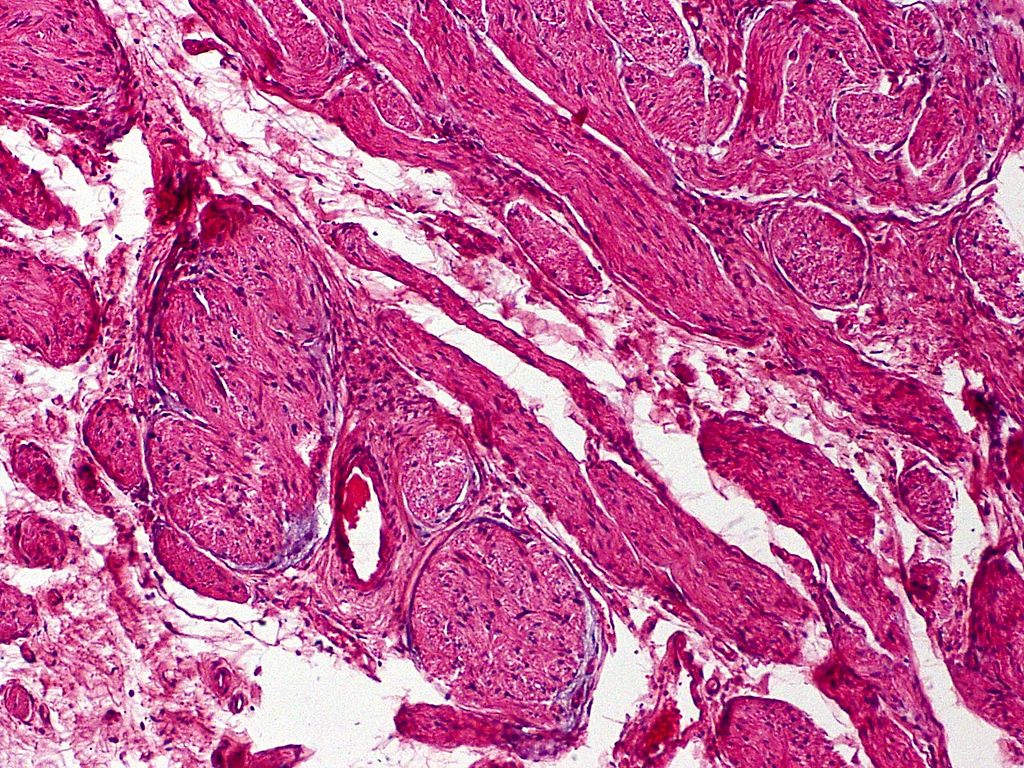 |
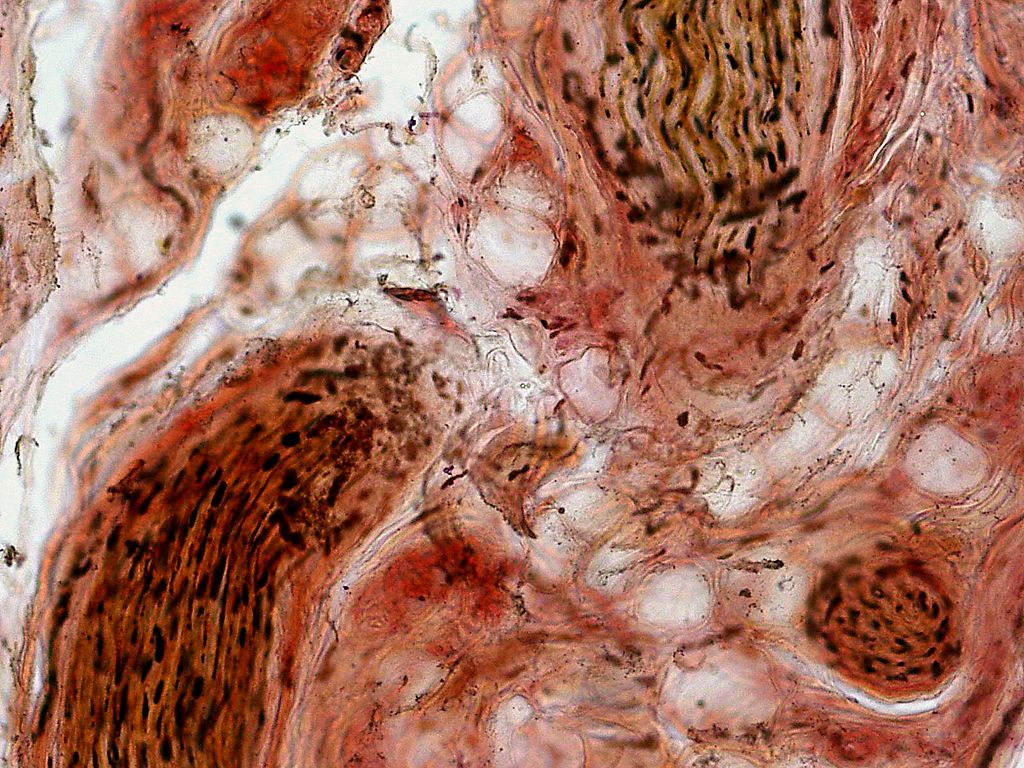 |
Common sites of involvement by traumatic neuroma
Causes
- Common causes of neuroma include:[37][38]
- Indirect nerve trauma
- Especially during a surgery
- Cone biopsy (rare complication)
- 55% of hysterectomy patients have microneuromas, associated with childbirth
- Traction injury
- Chronic repetitive stress
- Indirect nerve trauma
- Morton's neuroma is associated with:
- Wearing tight shoes and high heels
- Overpronation
- Abnormal positioning of toes
- Flat feet
- Forefoot problems such as:
- High foot arches
Epidemiology and Demographics
Age
- Neuroma is more commonly observed among patients aged between 15 to 50 years old[38]
- Neuroma is more commonly observed among middle aged adults
Gender
- Females are more commonly affected with neuroma than males
- The female to male ratio is approximately 5:1[38]
Race
- There is no racial predilection for neuroma
Risk Factors
- Common risk factors in the development of neuroma include:[37]
Natural History, Complications and Prognosis
- The majority of patients with neuroma are symptomatic at the time of diagnosis[1]
- Early clinical features include neuropathic pain or local tenderness
- If left untreated, the majority of patients with neuroma may progress to develop difficulty walking and limping
- A significant complication of neuroma is chronic neuropathic pain
- Prognosis is generally good, and the survival rate of patients with neuroma is 99%[39][40]
Diagnosis
Symptoms
- Neuroma is usually asymptomatic
- Symptoms of neuroma may include:[1]
- Focal area of traumatic neuropathic pain radiating to toes, with the presence of a typical trigger point in the area of a neuroma (especially with the pressure application) causing the patient to feel:[41]
- Shooting
- Burning
- Stabbing
- Raw
- Gnawing
- Sickening sensations
- Numbness
- Paresthesia over the injured area
- Dysesthesia (painful hypersensitivity to normal light tactile stimuli)
- Functional impairment
- Psychological distress (severely decreasing the quality of life)
- Focal area of traumatic neuropathic pain radiating to toes, with the presence of a typical trigger point in the area of a neuroma (especially with the pressure application) causing the patient to feel:[41]
Physical Examination
- Patients with neuroma usually appear with antalgic posture[1]
- Physical examination may be remarkable for:
- Tenderness to palpation
- Limitation of range of motion
- Dysesthetic pain
- Mulder's sign:
- Replication of symptoms or clicking sensations upon direct pressure between the metatarsal heads or compression of transverse arch in forefoot between the finger and thumb
Laboratory Findings
- There are no specific laboratory findings associated with neuroma[37]
Imaging Findings
MRI
- On MRI, characteristic findings of neuroma include:[42][43][44][45][46][47][48][49][7][50][51][7]
- On MRI, characteristic findings of traumatic neuroma include:[1]
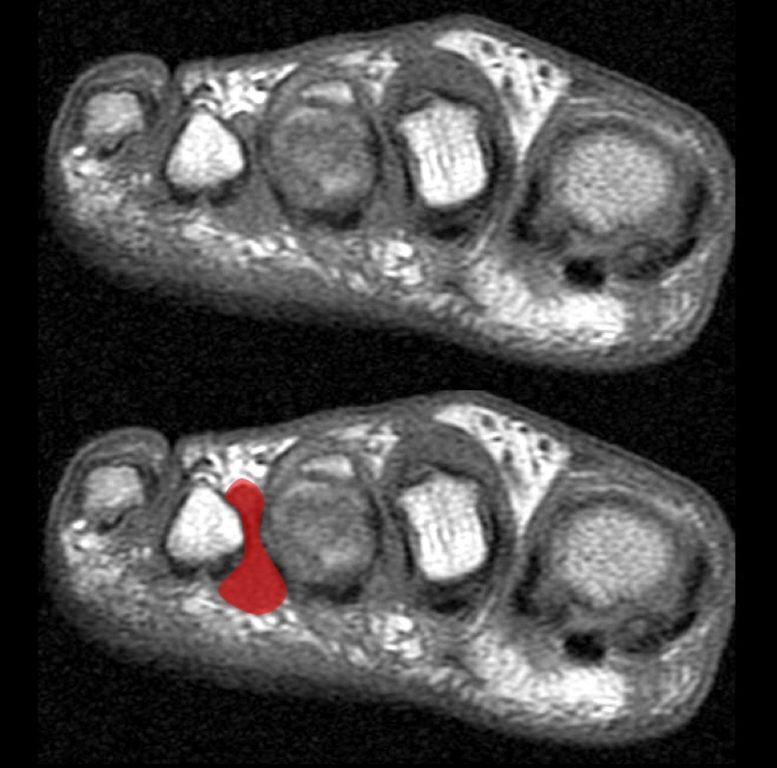 |
Ultrasound
- Ultrasound can help distinguish neuroma from:[52][53][54]
- Intermetatarsal bursal swelling or
- Synovitis in adjacent joints
- On ultrasound, neuroma is characterized by the following findings:[1][55][56][57][58][59][60][61][62][6][63]
- Round to ovoid
- Well-defined, hypoechoic lesion
- Located in the intermetatarsal space proximal to the metatarsal head
- On ultrasound, traumatic neuroma is characterized by the following findings:[1]
Treatment
Medical Therapy
Conservative therapy for Morton's neuroma
- Morton's neuroma should be managed conservatively before proceeding to expensive diagnostic procedures
- Conservative measures for pain relief include:[64][65][66][67][68][69]
- Decreasing pressure on the metatarsal heads by using:
- Metatarsal support
- Metatarsal bars
- Padding techniques (it's important to place inserts properly just proximal to the metatarsal head), such as:
- Metatarsal pads
- Toe crest pads
- Tapping the toe area
- Shoe inserts (orthotics) help in correcting any mechanical imbalance in the foot
- Specialized orthopedic shoes
- Comfortable shoes (with the help of a professional shoe fitting device) having:
- Wider toe box allowing spread of metatarsal heads
- Low heels
- Good arch support
- Physical therapy
- Ice massage
- Strength exercises for intrinsic foot muscles
- Resting
- Decreasing pressure on the metatarsal heads by using:
Non-conservative medical therapy
- When conservative measures fail, following medical therapy is used for non-surgical treatment of neuroma:[1]
- Tricyclic antidepressants
- Anticonvulsants (more effective)
- Serotonin-norepinephrine reuptake inhibitors
- Ultrasound-guided interdigital injection of following nerve blocking agents via dorsal approach into the site of tenderness:[70][71][72][73][74][75][76][77][78][79][80][81][82][83][9][84][85][86][87]
- Anti-inflammatory drugs (orally or injected into the toe area), such as:
- Painkillers (not recommended for long-term treatment)
Surgery
- Surgical excision is the treatment of choice for neuroma[88][89][90][91][92][93][94][95][96][97][98][99][100][39]
- Surgical excision is associated with a relatively favorable success rate of approximately 80%
- Recurrence rate after surgery is as high as 50%
Prevention
- There are no primary preventive measures available for neuroma[1]
- Secondary prevention measures include: personal hygiene measures, such as wearing ergonomic shoes
Differential Diagnosis
- Neuroma must be differentiated from other diseases that cause forefoot pain and numbness such as:[1][38]
References
- ↑ 1.00 1.01 1.02 1.03 1.04 1.05 1.06 1.07 1.08 1.09 1.10 Neuroma. Radiopedia http://radiopaedia.org/cases/morton-neuroma-2 Accessed on April 21, 2016
- ↑ "Neuroma". Dorland's Illustrated Medical Dictionary (32nd ed.). Oxford University Press. 2011. p. 5287. ISBN 978-1-4557-0985-4. Retrieved 25 August 2013.
- ↑ Valero J, Gallart J, González D, Deus J, Lahoz M (2015). "Multiple interdigital neuromas: a retrospective study of 279 feet with 462 neuromas". J Foot Ankle Surg. 54 (3): 320–2. doi:10.1053/j.jfas.2014.05.011. PMID 25128316.
- ↑ 4.0 4.1 Golan JD, Jacques L (2004). "Nonneoplastic peripheral nerve tumors". Neurosurg Clin N Am. 15 (2): 223–30. doi:10.1016/j.nec.2004.02.001. PMID 15177321.
- ↑ Kim JY, Choi JH, Park J, Wang J, Lee I (2007). "An anatomical study of Morton's interdigital neuroma: the relationship between the occurring site and the deep transverse metatarsal ligament (DTML)". Foot Ankle Int. 28 (9): 1007–10. doi:10.3113/FAI.2007.1007. PMID 17880876.
- ↑ 6.0 6.1 Read JW, Noakes JB, Kerr D, Crichton KJ, Slater HK, Bonar F (1999). "Morton's metatarsalgia: sonographic findings and correlated histopathology". Foot Ankle Int. 20 (3): 153–61. doi:10.1177/107110079902000303. PMID 10195292.
- ↑ 7.0 7.1 7.2 Bencardino J, Rosenberg ZS, Beltran J, Liu X, Marty-Delfaut E (2000). "Morton's neuroma: is it always symptomatic?". AJR Am J Roentgenol. 175 (3): 649–53. doi:10.2214/ajr.175.3.1750649. PMID 10954445.
- ↑ Bourke G, Owen J, Machet D (1994). "Histological comparison of the third interdigital nerve in patients with Morton's metatarsalgia and control patients". Aust N Z J Surg. 64 (6): 421–4. PMID 7516653.
- ↑ 9.0 9.1 Wu KK (1996). "Morton's interdigital neuroma: a clinical review of its etiology, treatment, and results". J Foot Ankle Surg. 35 (2): 112–9, discussion 187-8. PMID 8722878.
- ↑ Post MD (2019). "Mechanical Diagnosis and Therapy and Morton's Neuroma: A Case Report". Physiother Can. 71 (2): 130–133. doi:10.3138/ptc.2018-42. PMC 6484954. PMID 31040508.
- ↑ Foltán R, Klíma K, Spacková J, Sedý J (2008). "Mechanism of traumatic neuroma development". Med Hypotheses. 71 (4): 572–6. doi:10.1016/j.mehy.2008.05.010. PMID 18599222.
- ↑ Yao C, Zhou X, Zhao B, Sun C, Poonit K, Yan H (2017). "Treatments of traumatic neuropathic pain: a systematic review". Oncotarget. 8 (34): 57670–57679. doi:10.18632/oncotarget.16917. PMC 5593675. PMID 28915703.
- ↑ Colella G, Borriello C, Lanza A, Rossiello R, Siniscalchi G (2002). "[Traumatic neuroma of the great auricular nerve. A clinical case]". Minerva Stomatol. 51 (6): 279–83. PMID 12147981.
- ↑ Moss CE, Johnston CJ, Whear NM (2000). "Amputation neuroma of the great auricular nerve after operations on the parotid gland". Br J Oral Maxillofac Surg. 38 (5): 537–8. doi:10.1054/bjom.2000.0466. PMID 11010790.
- ↑ Hobsley M (1972). "Amputation neuroma of the great auricular nerve after parotidectomy". Br J Surg. 59 (9): 735–6. PMID 4341800.
- ↑ Toriumi DM, Sykes J, Wolff A (1987). "Pathologic quiz case 1. Amputation neuroma of the great auricular nerve". Arch Otolaryngol Head Neck Surg. 113 (8): 888–90. PMID 3620156.
- ↑ De Roos KP, Neumann HA (1994). "Traumatic neuroma. A rare complication following Muller's phlebectomy". J Dermatol Surg Oncol. 20 (10): 681–2. PMID 7930014.
- ↑ 18.0 18.1 Lee EJ, Calcaterra TC, Zuckerbraun L (1998). "Traumatic neuromas of the head and neck". Ear Nose Throat J. 77 (8): 670–4, 676. PMID 9745184.
- ↑ Li Q, Gao EL, Yang YL, Hu HY, Hu XQ (2012). "Traumatic neuroma in a patient with breast cancer after mastectomy: a case report and review of the literature". World J Surg Oncol. 10: 35. doi:10.1186/1477-7819-10-35. PMC 3296625. PMID 22330690.
- ↑ Chen W, Zhang H, Huang J, Li Y, Zhang Z, Peng Y (2019). "Traumatic neuroma in mastectomy scar: Two case reports and review of the literature". Medicine (Baltimore). 98 (15): e15142. doi:10.1097/MD.0000000000015142. PMID 30985684.
- ↑ Baltalarli B, Demirkan N, Yağci B (2004). "Traumatic neuroma: unusual benign lesion occurring in the mastectomy scar". Clin Oncol (R Coll Radiol). 16 (7): 503–4. PMID 15490816.
- ↑ Rosso R, Scelsi M, Carnevali L (2000). "Granular cell traumatic neuroma: a lesion occurring in mastectomy scars". Arch Pathol Lab Med. 124 (5): 709–11. doi:10.1043/0003-9985(2000)124<0709:GCTN>2.0.CO;2. PMID 10782152.
- ↑ Nomura H, Harimaya K, Orii H, Shiba K, Ueta T, Iwaki T (2002). "Traumatic neuroma of the anterior cervical nerve root with no subjective episode of trauma. Report of four cases". J Neurosurg. 97 (3 Suppl): 393–6. PMID 12408400.
- ↑ Arishima H, Takeuchi H, Tsunetoshi K, Kodera T, Kitai R, Kikuta K (2013). "Intraoperative and pathological findings of intramedullary amputation neuroma associated with spinal ependymoma". Brain Tumor Pathol. 30 (3): 196–200. doi:10.1007/s10014-012-0125-x. PMC 3714552. PMID 23187747.
- ↑ Ulrich CT, Sommerlad D, Szelenyi A, Seifert V, Marquardt G (2010). "Concurrent schwannoma and intradural neuroma after resection of a cauda equina schwannoma. A case report and first description". Acta Neurochir (Wien). 152 (6): 1061–3, discussion 1063. doi:10.1007/s00701-009-0534-8. PMID 19834641.
- ↑ Salas SJ, McFalls JM, Senders ZJ, Kenyon LC, Harrop JS (2013). "Intradural cervical nerve root traumatic neuroma without a history of direct trauma". Clin Neurol Neurosurg. 115 (9): 1879–81. doi:10.1016/j.clineuro.2013.03.018. PMID 23639732.
- ↑ Kang J, Yang P, Zang Q, He X (2016). "Traumatic neuroma of the superficial peroneal nerve in a patient: a case report and review of the literature". World J Surg Oncol. 14 (1): 242. doi:10.1186/s12957-016-0990-6. PMC 5018173. PMID 27613606.
- ↑ Santoro M, Carlomagno F, Romano A, Bottaro DP, Dathan NA, Grieco M; et al. (1995). "Activation of RET as a dominant transforming gene by germline mutations of MEN2A and MEN2B". Science. 267 (5196): 381–3. PMID 7824936.
- ↑ Thapa PB, Shahi S, Jha RK, Shrestha D (2019). "Vestibular Schwanomma: An Experience in a Developing World". World J Oncol. 10 (2): 118–122. doi:10.14740/wjon1195. PMC 6497013. PMID 31068992.
- ↑ Zanardi F, Cooke RM, Maiorana A, Curti S, Farioli A, Bonfiglioli R; et al. (2011). ""Is this case of a very rare disease work-related?" A review of reported cases of Pacinian neuroma". Scand J Work Environ Health. 37 (3): 253–8. doi:10.5271/sjweh.3132. PMID 21082159.
- ↑ Cho HH, Hong JS, Park SY, Park HS, Cho S, Lee JH (2012). "Tender papule rising on the digit: Pacinian neuroma should be considered in differential diagnosis". Int J Med Sci. 9 (1): 83–5. PMC 3245416. PMID 22211094.
- ↑ Ide F, Shimoyama T, Kaneko T, Horie N (2006). "Pacinian neuroma in adipose herniation of the buccal mucosa". Int J Oral Maxillofac Surg. 35 (12): 1162–3. doi:10.1016/j.ijom.2006.06.025. PMID 17008055.
- ↑ Rhode CM, Jennings WD (1975). "Pacinian corpuscle neuroma of digital nerves". South Med J. 68 (1): 86–9. PMID 1154066.
- ↑ Kitcat M, Hunter JE, Malata CM (2009). "Sciatic neuroma presenting forty years after above-knee amputation". Open Orthop J. 3: 125–7. doi:10.2174/1874325000903010125. PMC 2835865. PMID 20224738.
- ↑ Hanna SA, Catapano J, Borschel GH (2016). "Painful pediatric traumatic neuroma: surgical management and clinical outcomes". Childs Nerv Syst. 32 (7): 1191–4. doi:10.1007/s00381-016-3109-z. PMID 27179535.
- ↑ Perry, Arie (2010). Practical surgical neuropathology : a diagnostic approach. Philadelphia, PA: Churchill Livingstone/Elsevier. ISBN 978-0443069826.
- ↑ 37.0 37.1 37.2 37.3 37.4 Neuroma. Wikipedia. https://en.wikipedia.org/wiki/Neuroma Accessed on April 21, 2016
- ↑ 38.0 38.1 38.2 38.3 38.4 38.5 38.6 Wu J, Chiu DT (1999). "Painful neuromas: a review of treatment modalities". Ann Plast Surg. 43 (6): 661–7. PMID 10597831.
- ↑ 39.0 39.1 Lee KT, Kim JB, Young KW, Park YU, Kim JS, Jegal H (2011). "Long-term results of neurectomy in the treatment of Morton's neuroma: more than 10 years' follow-up". Foot Ankle Spec. 4 (6): 349–53. doi:10.1177/1938640011428510. PMID 22134434.
- ↑ Bauer T, Gaumetou E, Klouche S, Hardy P, Maffulli N (2015). "Metatarsalgia and Morton's Disease: Comparison of Outcomes Between Open Procedure and Neurectomy Versus Percutaneous Metatarsal Osteotomies and Ligament Release With a Minimum of 2 Years of Follow-Up". J Foot Ankle Surg. 54 (3): 373–7. doi:10.1053/j.jfas.2014.08.009. PMID 25481724.
- ↑ Locke RK (1993). "Morton's neuroma". J Am Podiatr Med Assoc. 83 (2): 108–9. doi:10.7547/87507315-83-2-108. PMID 8478796.
- ↑ AlSharif S, Ferré R, Omeroglu A, El Khoury M, Mesurolle B (2016). "Imaging Features Associated With Posttraumatic Breast Neuromas". AJR Am J Roentgenol. 206 (3): 660–5. doi:10.2214/AJR.14.14035. PMID 26901025.
- ↑ Ahlawat S, Belzberg AJ, Montgomery EA, Fayad LM (2016). "MRI features of peripheral traumatic neuromas". Eur Radiol. 26 (4): 1204–12. doi:10.1007/s00330-015-3907-9. PMID 26188658.
- ↑ Zanetti M, Ledermann T, Zollinger H, Hodler J (1997). "Efficacy of MR imaging in patients suspected of having Morton's neuroma". AJR Am J Roentgenol. 168 (2): 529–32. doi:10.2214/ajr.168.2.9016241. PMID 9016241.
- ↑ Williams JW, Meaney J, Whitehouse GH, Klenerman L, Hussein Z (1997). "MRI in the investigation of Morton's neuroma: which sequences?". Clin Radiol. 52 (1): 46–9. PMID 9022580.
- ↑ Unger HR, Mattoso PQ, Drusen MJ, Neumann CH (1992). "Gadopentetate-enhanced magnetic resonance imaging with fat saturation in the evaluation of Morton's neuroma". J Foot Surg. 31 (3): 244–6. PMID 1619223.
- ↑ Lee MJ, Kim S, Huh YM, Song HT, Lee SA, Lee JW; et al. (2007). "Morton neuroma: evaluated with ultrasonography and MR imaging". Korean J Radiol. 8 (2): 148–55. doi:10.3348/kjr.2007.8.2.148. PMC 2626779. PMID 17420632.
- ↑ Weishaupt D, Treiber K, Kundert HP, Zollinger H, Vienne P, Hodler J; et al. (2003). "Morton neuroma: MR imaging in prone, supine, and upright weight-bearing body positions". Radiology. 226 (3): 849–56. doi:10.1148/radiol.2263011925. PMID 12601213.
- ↑ Torres-Claramunt R, Ginés A, Pidemunt G, Puig L, de Zabala S (2012). "MRI and ultrasonography in Morton's neuroma: Diagnostic accuracy and correlation". Indian J Orthop. 46 (3): 321–5. doi:10.4103/0019-5413.96390. PMC 3377144. PMID 22719120.
- ↑ Weishaupt D, Treiber K, Jacob HA, Kundert HP, Hodler J, Marincek B; et al. (2002). "MR imaging of the forefoot under weight-bearing conditions: position-related changes of the neurovascular bundles and the metatarsal heads in asymptomatic volunteers". J Magn Reson Imaging. 16 (1): 75–84. doi:10.1002/jmri.10130. PMID 12112506.
- ↑ Studler U, Mengiardi B, Bode B, Schöttle PB, Pfirrmann CW, Hodler J; et al. (2008). "Fibrosis and adventitious bursae in plantar fat pad of forefoot: MR imaging findings in asymptomatic volunteers and MR imaging-histologic comparison". Radiology. 246 (3): 863–70. doi:10.1148/radiol.2463070196. PMID 18195378.
- ↑ Fazal MA, Khan I, Thomas C (2012). "Ultrasonography and magnetic resonance imaging in the diagnosis of Morton's neuroma". J Am Podiatr Med Assoc. 102 (3): 184–6. PMID 22659760.
- ↑ Pastides P, El-Sallakh S, Charalambides C (2012). "Morton's neuroma: A clinical versus radiological diagnosis". Foot Ankle Surg. 18 (1): 22–4. doi:10.1016/j.fas.2011.01.007. PMID 22325999.
- ↑ Sharp RJ, Wade CM, Hennessy MS, Saxby TS (2003). "The role of MRI and ultrasound imaging in Morton's neuroma and the effect of size of lesion on symptoms". J Bone Joint Surg Br. 85 (7): 999–1005. PMID 14516035.
- ↑ Coraci D, Pazzaglia C, Doneddu PE, Erra C, Paolasso I, Santilli V; et al. (2015). "Post-traumatic neuroma due to closed nerve injury. Is recovery after peripheral nerve trauma related to ultrasonographic neuroma size?". Clin Neurol Neurosurg. 139: 314–8. doi:10.1016/j.clineuro.2015.10.034. PMID 26571458.
- ↑ Quinn TJ, Jacobson JA, Craig JG, van Holsbeeck MT (2000). "Sonography of Morton's neuromas". AJR Am J Roentgenol. 174 (6): 1723–8. doi:10.2214/ajr.174.6.1741723. PMID 10845513.
- ↑ Pollak RA, Bellacosa RA, Dornbluth NC, Strash WW, Devall JM (1992). "Sonographic analysis of Morton's neuroma". J Foot Surg. 31 (6): 534–7. PMID 1469213.
- ↑ Tobajas Asensio E, Tobajas Asensio JA, Boada Apilluelo E, Torres Nuez J (2000). "[Echography evaluation of Morton's neuroma]". An Med Interna. 17 (8): 416–8. PMID 11218988.
- ↑ Shapiro PP, Shapiro SL (1995). "Sonographic evaluation of interdigital neuromas". Foot Ankle Int. 16 (10): 604–6. doi:10.1177/107110079501601003. PMID 8574369.
- ↑ Sobiesk GA, Wertheimer SJ, Schulz R, Dalfovo M (1997). "Sonographic evaluation of interdigital neuromas". J Foot Ankle Surg. 36 (5): 364–6. PMID 9356915.
- ↑ Levine SE, Myerson MS, Shapiro PP, Shapiro SL (1998). "Ultrasonographic diagnosis of recurrence after excision of an interdigital neuroma". Foot Ankle Int. 19 (2): 79–84. doi:10.1177/107110079801900205. PMID 9498579.
- ↑ Kankanala G, Jain AS (2007). "The operational characteristics of ultrasonography for the diagnosis of plantar intermetatarsal neuroma". J Foot Ankle Surg. 46 (4): 213–7. doi:10.1053/j.jfas.2007.04.001. PMID 17586431.
- ↑ Perini L, Del Borrello M, Cipriano R, Cavallo A, Volpe A (2006). "Dynamic sonography of the forefoot in Morton's syndrome: correlation with magnetic resonance and surgery". Radiol Med. 111 (7): 897–905. doi:10.1007/s11547-006-0088-2. PMID 17021692.
- ↑ Kang JH, Chen MD, Chen SC, Hsi WL (2006). "Correlations between subjective treatment responses and plantar pressure parameters of metatarsal pad treatment in metatarsalgia patients: a prospective study". BMC Musculoskelet Disord. 7: 95. doi:10.1186/1471-2474-7-95. PMC 1712337. PMID 17147793.
- ↑ Jannink M, van Dijk H, Ijzerman M, Groothuis-Oudshoorn K, Groothoff J, Lankhurst G (2006). "Effectiveness of custom-made orthopaedic shoes in the reduction of foot pain and pressure in patients with degenerative disorders of the foot". Foot Ankle Int. 27 (11): 974–9. doi:10.1177/107110070602701119. PMID 17144963.
- ↑ Hsi WL, Kang JH, Lee XX (2005). "Optimum position of metatarsal pad in metatarsalgia for pressure relief". Am J Phys Med Rehabil. 84 (7): 514–20. PMID 15973088.
- ↑ Jackson L, Binning J, Potter J (2004). "Plantar pressures in rheumatoid arthritis using prefabricated metatarsal padding". J Am Podiatr Med Assoc. 94 (3): 239–45. PMID 15153584.
- ↑ Chang AH, Abu-Faraj ZU, Harris GF, Nery J, Shereff MJ (1994). "Multistep measurement of plantar pressure alterations using metatarsal pads". Foot Ankle Int. 15 (12): 654–60. doi:10.1177/107110079401501205. PMID 7894637.
- ↑ Holmes GB, Timmerman L (1990). "A quantitative assessment of the effect of metatarsal pads on plantar pressures". Foot Ankle. 11 (3): 141–5. PMID 2074081.
- ↑ Malessy MJA, de Boer R, Muñoz Romero I, Eekhof JLA, van Zwet EW, Kliot M; et al. (2018). "Predictive value of a diagnostic block in focal nerve injury with neuropathic pain when surgery is considered". PLoS One. 13 (9): e0203345. doi:10.1371/journal.pone.0203345. PMC 6135496. PMID 30208078.
- ↑ Climent JM, Mondéjar-Gómez F, Rodríguez-Ruiz C, Díaz-Llopis I, Gómez-Gallego D, Martín-Medina P (2013). "Treatment of Morton neuroma with botulinum toxin A: a pilot study". Clin Drug Investig. 33 (7): 497–503. doi:10.1007/s40261-013-0090-0. PMC 3691490. PMID 23740337.
- ↑ Thomson CE, Beggs I, Martin DJ, McMillan D, Edwards RT, Russell D; et al. (2013). "Methylprednisolone injections for the treatment of Morton neuroma: a patient-blinded randomized trial". J Bone Joint Surg Am. 95 (9): 790–8, S1. doi:10.2106/JBJS.I.01780. PMID 23636185.
- ↑ Schon L (2014). "An injection of corticosteroid plus anesthetic was more effective than anesthetic alone for Morton neuroma". J Bone Joint Surg Am. 96 (4): 334. doi:10.2106/JBJS.9604.ebo028. PMID 24553891.
- ↑ Smith RW (2013). "Steroid injection for Morton neuroma - data-based justification". J Bone Joint Surg Am. 95 (9): e64. doi:10.2106/JBJS.M.00172. PMID 23636203.
- ↑ Haddad-Zebouni S, Elia D, Aoun N, Okais J, Ghossain M (2006). "[Regression of Morton neuroma after local injection of steroids]". J Radiol. 87 (5): 566–8. PMID 16733414.
- ↑ Basadonna PT, Rucco V, Gasparini D, Onorato A (1999). "Plantar fat pad atrophy after corticosteroid injection for an interdigital neuroma: a case report". Am J Phys Med Rehabil. 78 (3): 283–5. PMID 10340428.
- ↑ Reddy PD, Zelicof SB, Ruotolo C, Holder J (1995). "Interdigital neuroma. Local cutaneous changes after corticosteroid injection". Clin Orthop Relat Res (317): 185–7. PMID 7671475.
- ↑ van Vendeloo SN, Ettema HB (2016). "Skin depigmentation along lymph vessels of the lower leg following local corticosteroid injection for interdigital neuroma". Foot Ankle Surg. 22 (2): 139–41. doi:10.1016/j.fas.2016.01.002. PMID 27301735.
- ↑ Park YH, Lee JW, Choi GW, Kim HJ (2018). "Risk factors and the associated cutoff values for failure of corticosteroid injection in treatment of Morton's neuroma". Int Orthop. 42 (2): 323–329. doi:10.1007/s00264-017-3707-8. PMID 29230531.
- ↑ Mahadevan D, Salmasi M, Whybra N, Nanda A, Gaba S, Mangwani J (2016). "What factors predict the need for further intervention following corticosteroid injection of Morton's neuroma?". Foot Ankle Surg. 22 (1): 9–11. doi:10.1016/j.fas.2015.03.007. PMID 26869493.
- ↑ Mahadevan D, Attwal M, Bhatt R, Bhatia M (2016). "Corticosteroid injection for Morton's neuroma with or without ultrasound guidance: a randomised controlled trial". Bone Joint J. 98-B (4): 498–503. doi:10.1302/0301-620X.98B4.36880. PMID 27037432.
- ↑ Yap LP, McNally E (2012). "Patient's assessment of discomfort during ultrasound-guided injection of Morton's neuroma: selecting the optimal approach". J Clin Ultrasound. 40 (6): 330–4. doi:10.1002/jcu.21926. PMID 22585530.
- ↑ Hughes RJ, Ali K, Jones H, Kendall S, Connell DA (2007). "Treatment of Morton's neuroma with alcohol injection under sonographic guidance: follow-up of 101 cases". AJR Am J Roentgenol. 188 (6): 1535–9. doi:10.2214/AJR.06.1463. PMID 17515373.
- ↑ Rasmussen MR, Kitaoka HB, Patzer GL (1996). "Nonoperative treatment of plantar interdigital neuroma with a single corticosteroid injection". Clin Orthop Relat Res (326): 188–93. doi:10.1097/00003086-199605000-00022. PMID 8620640.
- ↑ Markovic M, Crichton K, Read JW, Lam P, Slater HK (2008). "Effectiveness of ultrasound-guided corticosteroid injection in the treatment of Morton's neuroma". Foot Ankle Int. 29 (5): 483–7. doi:10.3113/FAI.2008.0483. PMID 18510900.
- ↑ Sofka CM, Adler RS, Ciavarra GA, Pavlov H (2007). "Ultrasound-guided interdigital neuroma injections: short-term clinical outcomes after a single percutaneous injection--preliminary results". HSS J. 3 (1): 44–9. doi:10.1007/s11420-006-9029-9. PMC 2504098. PMID 18751769.
- ↑ Hassouna H, Singh D, Taylor H, Johnson S (2007). "Ultrasound guided steroid injection in the treatment of interdigital neuralgia". Acta Orthop Belg. 73 (2): 224–9. PMID 17515235.
- ↑ Souza JM, Purnell CA, Cheesborough JE, Kelikian AS, Dumanian GA (2016). "Treatment of Foot and Ankle Neuroma Pain With Processed Nerve Allografts". Foot Ankle Int. 37 (10): 1098–1105. doi:10.1177/1071100716655348. PMC 5363503. PMID 27340257.
- ↑ Bibbo C, Rodrigues-Colazzo E, Finzen AG (2018). "Superficial Peroneal Nerve to Deep Peroneal Nerve Transfer With Allograft Conduit for Neuroma in Continuity". J Foot Ankle Surg. 57 (3): 514–517. doi:10.1053/j.jfas.2017.11.022. PMID 29685562.
- ↑ Gould JS, Naranje SM, McGwin G, Florence M, Cheppalli S (2013). "Use of collagen conduits in management of painful neuromas of the foot and ankle". Foot Ankle Int. 34 (7): 932–40. doi:10.1177/1071100713478927. PMID 23447512.
- ↑ Rungprai C, Cychosz CC, Phruetthiphat O, Femino JE, Amendola A, Phisitkul P (2015). "Simple Neurectomy Versus Neurectomy With Intramuscular Implantation for Interdigital Neuroma: A Comparative Study". Foot Ankle Int. 36 (12): 1412–24. doi:10.1177/1071100715596741. PMID 26297693.
- ↑ Williams EH, Williams CG, Rosson GD, Heitmiller RF, Dellon AL (2008). "Neurectomy for treatment of intercostal neuralgia". Ann Thorac Surg. 85 (5): 1766–70. doi:10.1016/j.athoracsur.2007.11.058. PMID 18442581.
- ↑ Sood MK, Elliot D (1998). "Treatment of painful neuromas of the hand and wrist by relocation into the pronator quadratus muscle". J Hand Surg Br. 23 (2): 214–9. PMID 9607662.
- ↑ Atherton DD, Leong JC, Anand P, Elliot D (2007). "Relocation of painful end neuromas and scarred nerves from the zone II territory of the hand". J Hand Surg Eur Vol. 32 (1): 38–44. doi:10.1016/j.jhsb.2006.10.013. PMID 17126969.
- ↑ Hazari A, Elliot D (2004). "Treatment of end-neuromas, neuromas-in-continuity and scarred nerves of the digits by proximal relocation". J Hand Surg Br. 29 (4): 338–50. doi:10.1016/j.jhsb.2004.01.005. PMID 15234497.
- ↑ Atherton DD, Fabre J, Anand P, Elliot D (2008). "Relocation of painful neuromas in Zone III of the hand and forearm". J Hand Surg Eur Vol. 33 (2): 155–62. doi:10.1177/1753193408087107. PMID 18443055.
- ↑ Mackinnon SE, Dellon AL (1987). "Results of treatment of recurrent dorsoradial wrist neuromas". Ann Plast Surg. 19 (1): 54–61. PMID 3631861.
- ↑ Park EH, Kim YS, Lee HJ, Koh YG (2013). "Metatarsal shortening osteotomy for decompression of Morton's neuroma". Foot Ankle Int. 34 (12): 1654–60. doi:10.1177/1071100713499905. PMID 23892930.
- ↑ Preston N, Peterson D, Allen J, Kawalec JS, Whitaker J (2018). "Deep Transverse Metatarsal Ligament Transection in Morton's Neuroma Excision: A Cadaveric Study Examining Effects on Metatarsal Alignment". Foot Ankle Spec. 11 (4): 342–346. doi:10.1177/1938640017735888. PMID 29047294.
- ↑ Kasparek M, Schneider W (2016). "Transection of the deep metatarsal transverse ligament in Morton's neuroma surgery does not increase risk of splayfoot development". Int Orthop. 40 (5): 953–7. doi:10.1007/s00264-015-2981-6. PMID 26344448.
- ↑ Kelsey JL, Bachrach LK, Procter-Gray E, Nieves J, Greendale GA, Sowers M; et al. (2007). "Risk factors for stress fracture among young female cross-country runners". Med Sci Sports Exerc. 39 (9): 1457–63. doi:10.1249/mss.0b013e318074e54b. PMID 17805074.
- ↑ Barton A, Worthington J (October 2009). "Genetic susceptibility to rheumatoid arthritis: an emerging picture". Arthritis Rheum. 61 (10): 1441–6. doi:10.1002/art.24672. PMID 19790122.
- ↑ Hitchon CA, Chandad F, Ferucci ED, Willemze A, Ioan-Facsinay A, van der Woude D, Markland J, Robinson D, Elias B, Newkirk M, Toes RM, Huizinga TW, El-Gabalawy HS (June 2010). "Antibodies to porphyromonas gingivalis are associated with anticitrullinated protein antibodies in patients with rheumatoid arthritis and their relatives". J. Rheumatol. 37 (6): 1105–12. doi:10.3899/jrheum.091323. PMID 20436074.
- ↑ Routsias JG, Goules JD, Goules A, Charalampakis G, Pikazis D (July 2011). "Autopathogenic correlation of periodontitis and rheumatoid arthritis". Rheumatology (Oxford). 50 (7): 1189–93. doi:10.1093/rheumatology/ker090. PMID 21343168.
- ↑ Barrett JH, Brennan P, Fiddler M, Silman AJ (June 1999). "Does rheumatoid arthritis remit during pregnancy and relapse postpartum? Results from a nationwide study in the United Kingdom performed prospectively from late pregnancy". Arthritis Rheum. 42 (6): 1219–27. doi:10.1002/1529-0131(199906)42:6<1219::AID-ANR19>3.0.CO;2-G. PMID 10366115.
- ↑ Louati K, Berenbaum F (October 2015). "Fatigue in chronic inflammation - a link to pain pathways". Arthritis Res. Ther. 17: 254. doi:10.1186/s13075-015-0784-1. PMC 4593220. PMID 26435495.
- ↑ Nikolaus S, Bode C, Taal E, van de Laar MA (July 2013). "Fatigue and factors related to fatigue in rheumatoid arthritis: a systematic review". Arthritis Care Res (Hoboken). 65 (7): 1128–46. doi:10.1002/acr.21949. PMID 23335492.
- ↑ Ridley LJ, Han J, Ridley WE, Xiang H (2018). "Claw toe". J Med Imaging Radiat Oncol. 62 Suppl 1: 126. doi:10.1111/1754-9485.07_12786. PMID 30309185.
- ↑ Ceccarini P, Rinonapoli G, Sebastiani E, Bisaccia M, Ceccarini A, Caraffa A (2019). "Clinical Comparison Between Shortening Osteotomy of the Proximal Phalanx Neck and Arthrodesis in Hammer Toe Surgery at Mid-TermFollow-Up". J Foot Ankle Surg. 58 (2): 221–225. doi:10.1053/j.jfas.2018.08.002. PMID 30553747.
- ↑ Doty JF, Fogleman JA (2018). "Treatment of Rigid Hammer-Toe Deformity: Permanent Versus Removable Implant Selection". Foot Ankle Clin. 23 (1): 91–101. doi:10.1016/j.fcl.2017.09.007. PMID 29362037.
- ↑ Mueller CM, Boden SA, Boden AL, Maidman SD, Cutler A, Mignemi D; et al. (2018). "Complication Rates and Short-Term Outcomes After Operative Hammertoe Correction in Older Patients". Foot Ankle Int. 39 (6): 681–688. doi:10.1177/1071100718755472. PMID 29444584.
- ↑ Ceccarini P, Ceccarini A, Rinonapoli G, Caraffa A (2015). "Correction of Hammer Toe Deformity of Lateral Toes With Subtraction Osteotomy of the Proximal Phalanx Neck". J Foot Ankle Surg. 54 (4): 601–6. doi:10.1053/j.jfas.2014.11.013. PMID 25746765.
- ↑ Basile A, Albo F, Via AG (2015). "Intramedullary Fixation System for the Treatment of Hammertoe Deformity". J Foot Ankle Surg. 54 (5): 910–6. doi:10.1053/j.jfas.2015.04.004. PMID 26028601.
- ↑ Catena F, Doty JF, Jastifer J, Coughlin MJ, Stevens F (2014). "Prospective study of hammertoe correction with an intramedullary implant". Foot Ankle Int. 35 (4): 319–25. doi:10.1177/1071100713519780. PMID 24443491.
- ↑ Obrador C, Losa-Iglesias M, Becerro-de-Bengoa-Vallejo R, Kabbash CA (2018). "Comparative Study of Intramedullary Hammertoe Fixation". Foot Ankle Int. 39 (4): 415–425. doi:10.1177/1071100717745854. PMID 29337598.
- ↑ Kramer WC, Parman M, Marks RM (2015). "Hammertoe correction with k-wire fixation". Foot Ankle Int. 36 (5): 494–502. doi:10.1177/1071100714568013. PMID 25677363.
- ↑ Rodriguez, Fausto J.; Folpe, Andrew L.; Giannini, Caterina; Perry, Arie (2012). "Pathology of peripheral nerve sheath tumors: diagnostic overview and update on selected diagnostic problems". Acta Neuropathologica. 123 (3): 295–319. doi:10.1007/s00401-012-0954-z. ISSN 0001-6322.
- ↑ Choi, Kwangmin; Komurov, Kakajan; Fletcher, Jonathan S.; Jousma, Edwin; Cancelas, Jose A.; Wu, Jianqiang; Ratner, Nancy (2017). "An inflammatory gene signature distinguishes neurofibroma Schwann cells and macrophages from cells in the normal peripheral nervous system". Scientific Reports. 7 (1). doi:10.1038/srep43315. ISSN 2045-2322.
- ↑ Liao, Chung-Ping; Booker, Reid C.; Brosseau, Jean-Philippe; Chen, Zhiguo; Mo, Juan; Tchegnon, Edem; Wang, Yong; Clapp, D. Wade; Le, Lu Q. (2018). "Contributions of inflammation and tumor microenvironment to neurofibroma tumorigenesis". Journal of Clinical Investigation. 128 (7): 2848–2861. doi:10.1172/JCI99424. ISSN 0021-9738.
- ↑ 120.0 120.1 Staser, K.; Yang, F.-C.; Clapp, D. W. (2010). "Mast cells and the neurofibroma microenvironment". Blood. 116 (2): 157–164. doi:10.1182/blood-2009-09-242875. ISSN 0006-4971.
- ↑ Muir, David; Neubauer, Debbie; Lim, Ingrid T.; Yachnis, Anthony T.; Wallace, Margaret R. (2001). "Tumorigenic Properties of Neurofibromin-Deficient Neurofibroma Schwann Cells". The American Journal of Pathology. 158 (2): 501–513. doi:10.1016/S0002-9440(10)63992-2. ISSN 0002-9440.
- ↑ Wilkinson, Lana M.; Manson, David; Smith, Charles R. (2004). "Best Cases from the AFIP". RadioGraphics. 24 (suppl_1): S237–S242. doi:10.1148/rg.24si035170. ISSN 0271-5333.
- ↑ Bernthal, Nicholas; Jones, Kevin; Monument, Michael; Liu, Ting; Viskochil, David; Randall, R. (2013). "Lost in Translation: Ambiguity in Nerve Sheath Tumor Nomenclature and Its Resultant Treatment Effect". Cancers. 5 (4): 519–528. doi:10.3390/cancers5020519. ISSN 2072-6694.
- ↑ Mautner, V. F.; Friedrich, R. E.; von Deimling, A.; Hagel, C.; Korf, B.; Knöfel, M. T.; Wenzel, R.; Fünsterer, C. (2003). "Malignant peripheral nerve sheath tumours in neurofibromatosis type 1: MRI supports the diagnosis of malignant plexiform neurofibroma". Neuroradiology. 45 (9): 618–625. doi:10.1007/s00234-003-0964-6. ISSN 0028-3940.
- ↑ Shen, M H; Harper, P S; Upadhyaya, M (1996). "Molecular genetics of neurofibromatosis type 1 (NF1)". Journal of Medical Genetics. 33 (1): 2–17. doi:10.1136/jmg.33.1.2. ISSN 1468-6244.
- ↑ Rubin, Joshua B.; Gutmann, David H. (2005). "Neurofibromatosis type 1 — a model for nervous system tumour formation?". Nature Reviews Cancer. 5 (7): 557–564. doi:10.1038/nrc1653. ISSN 1474-175X.
- ↑ Gray, Mark H. (1990). "Immunohistochemical Demonstration of Factor XIIIa Expression in Neurofibromas". Archives of Dermatology. 126 (4): 472. doi:10.1001/archderm.1990.01670280056009. ISSN 0003-987X.